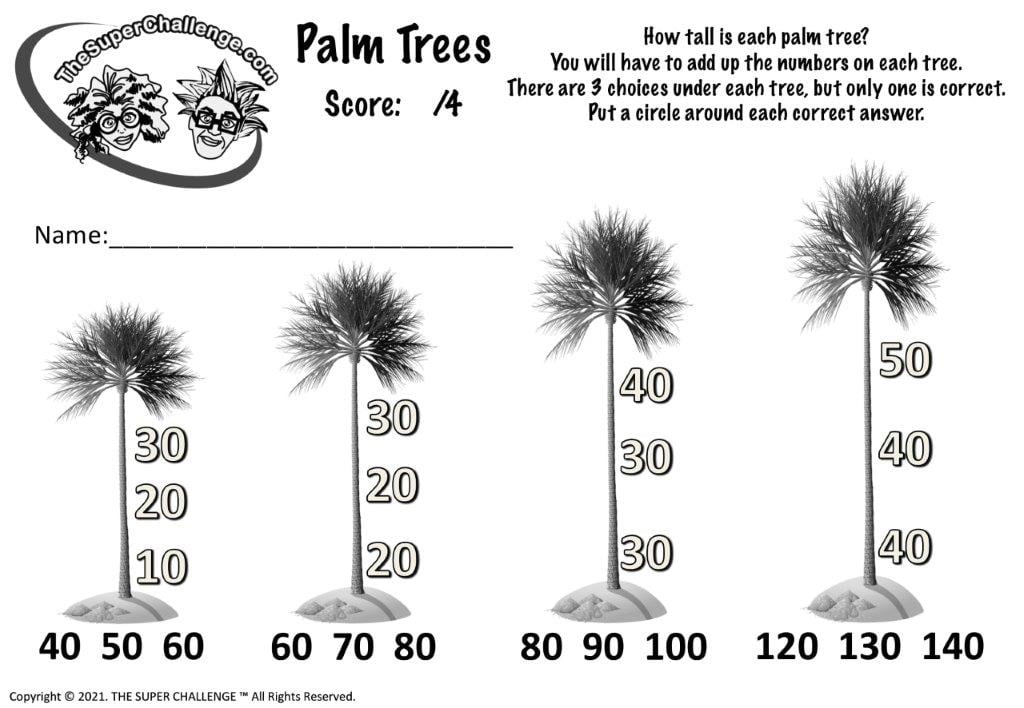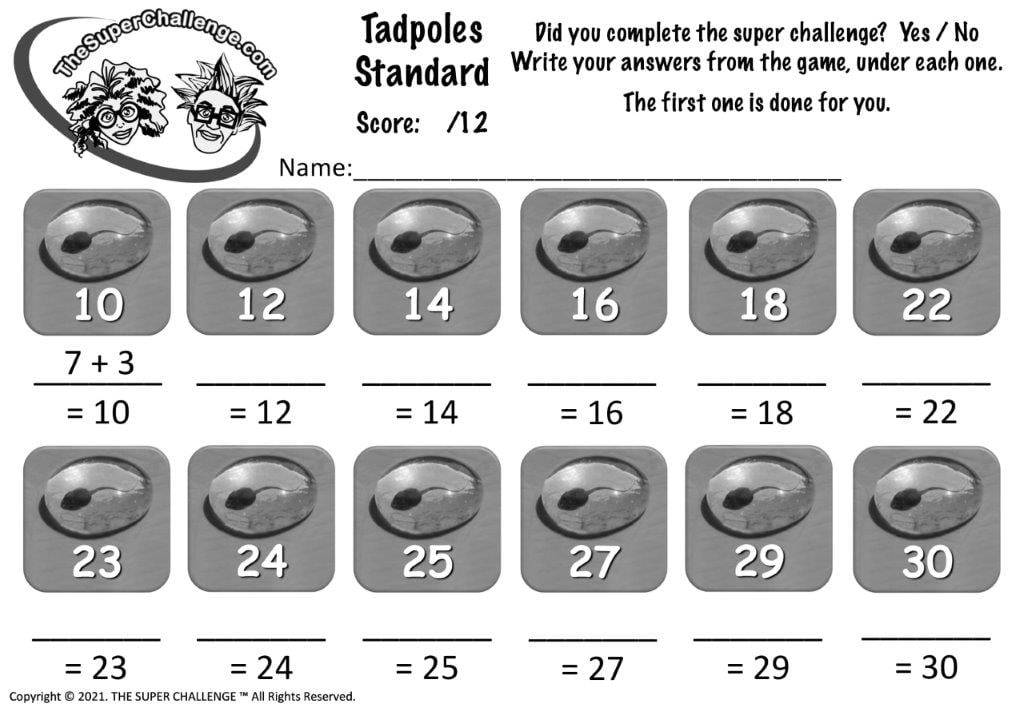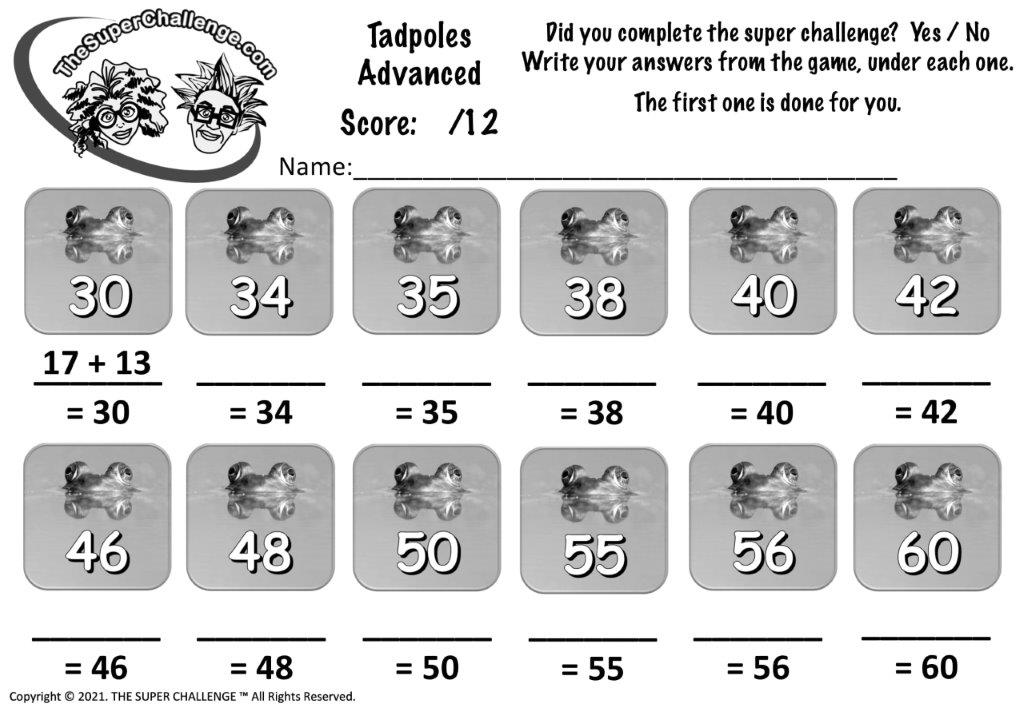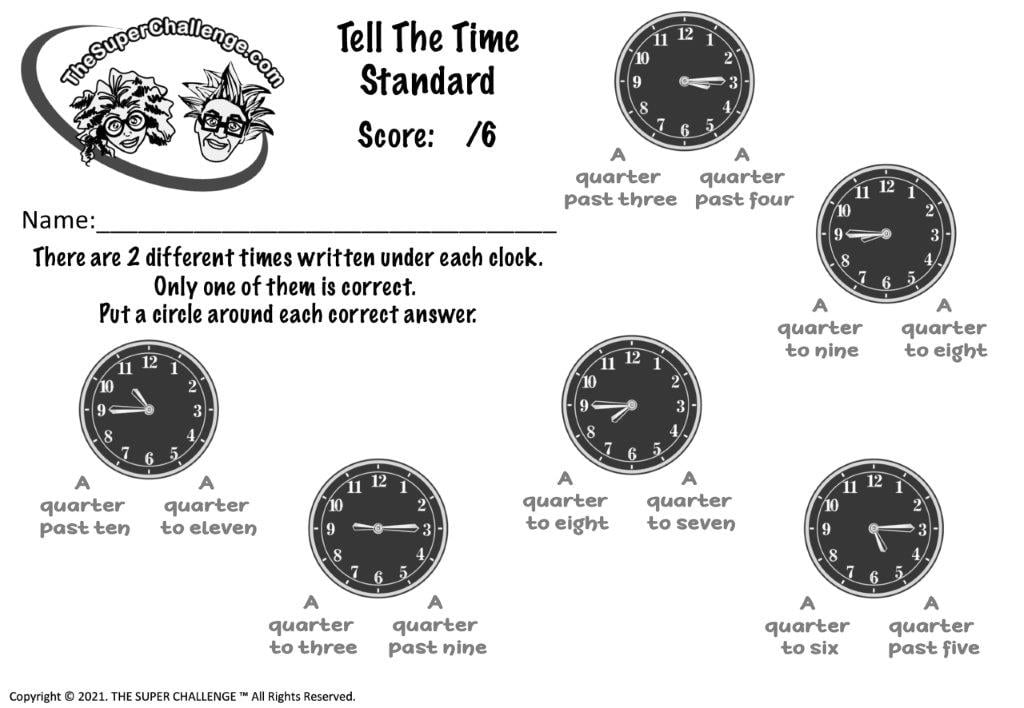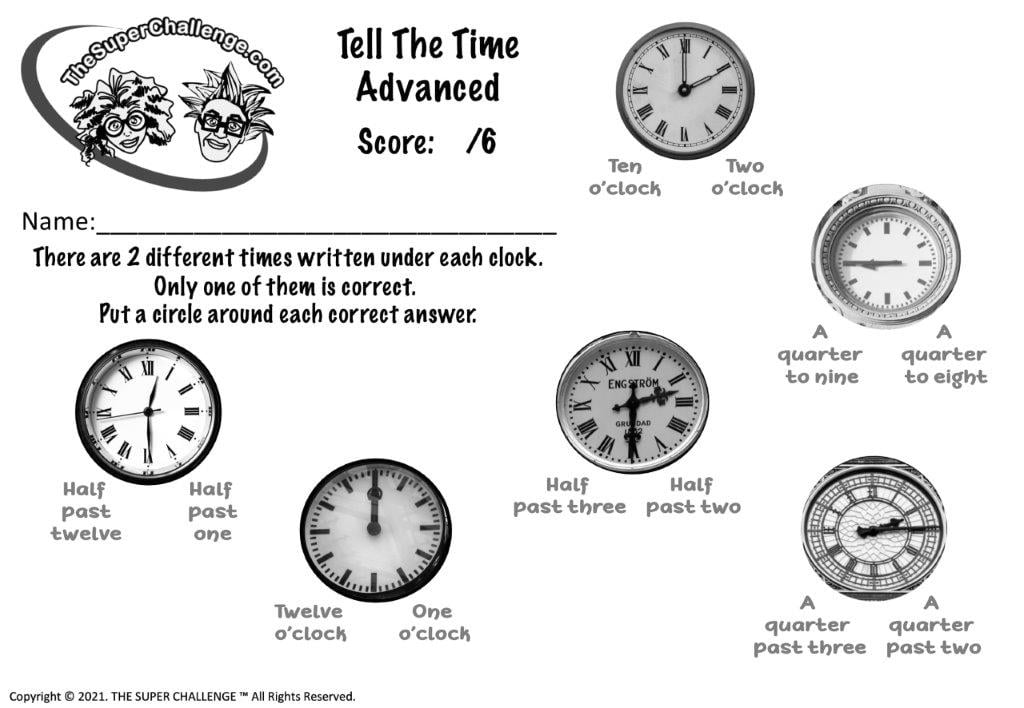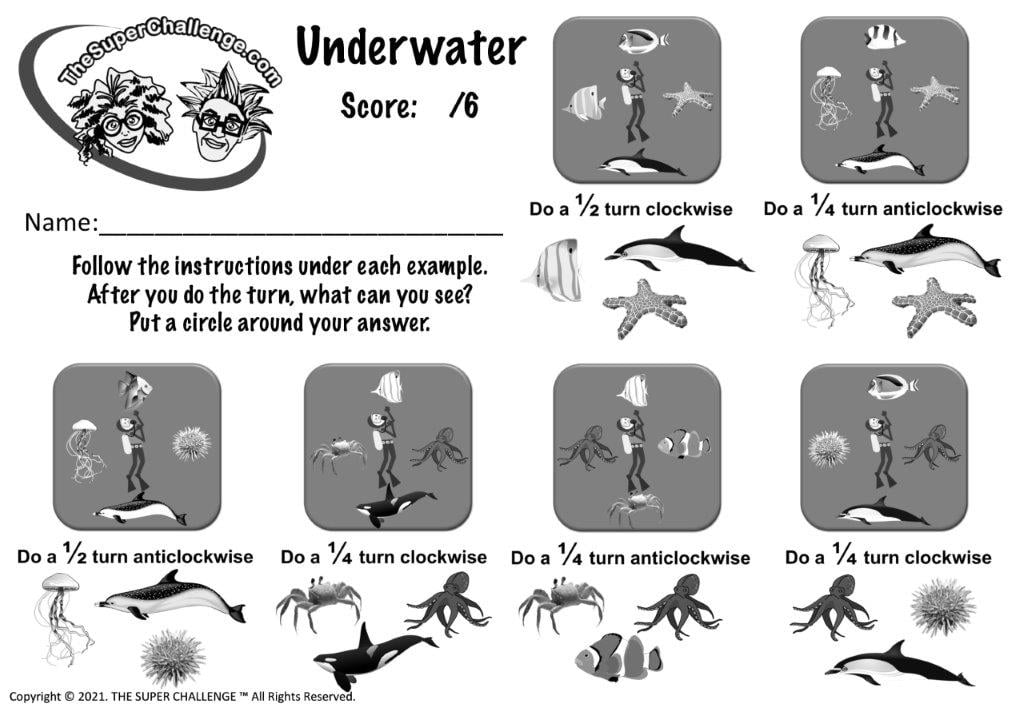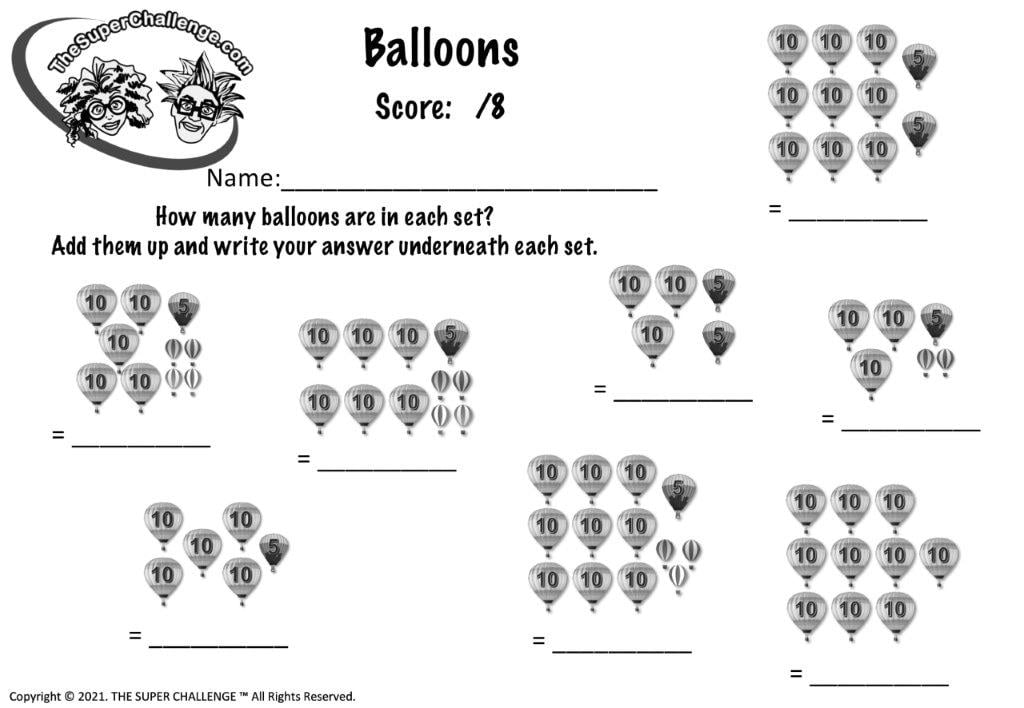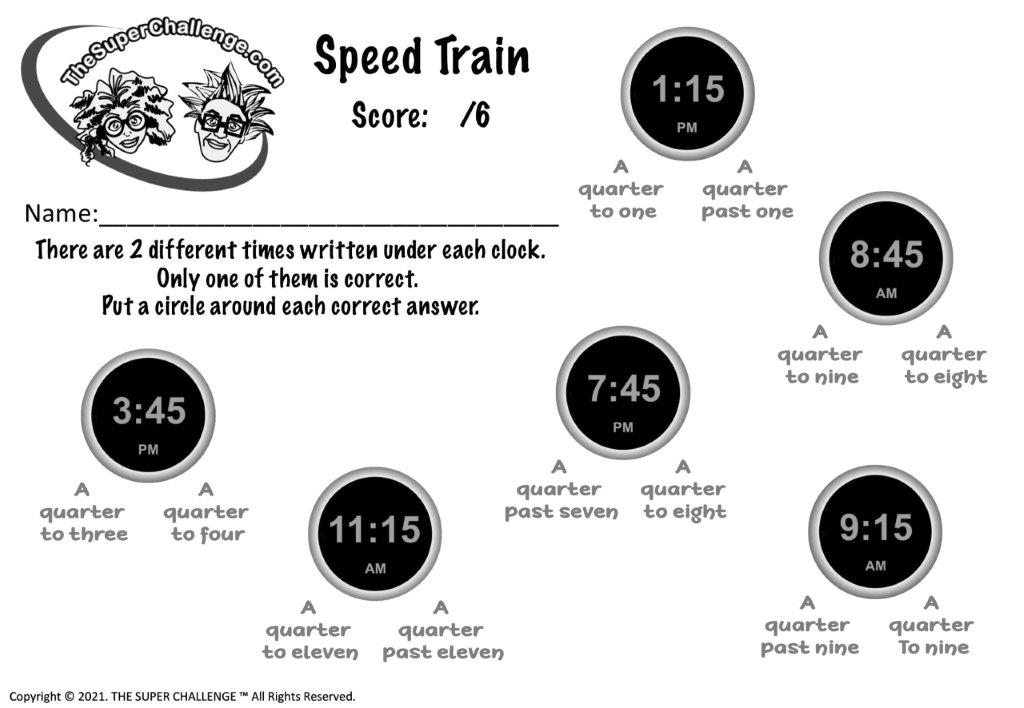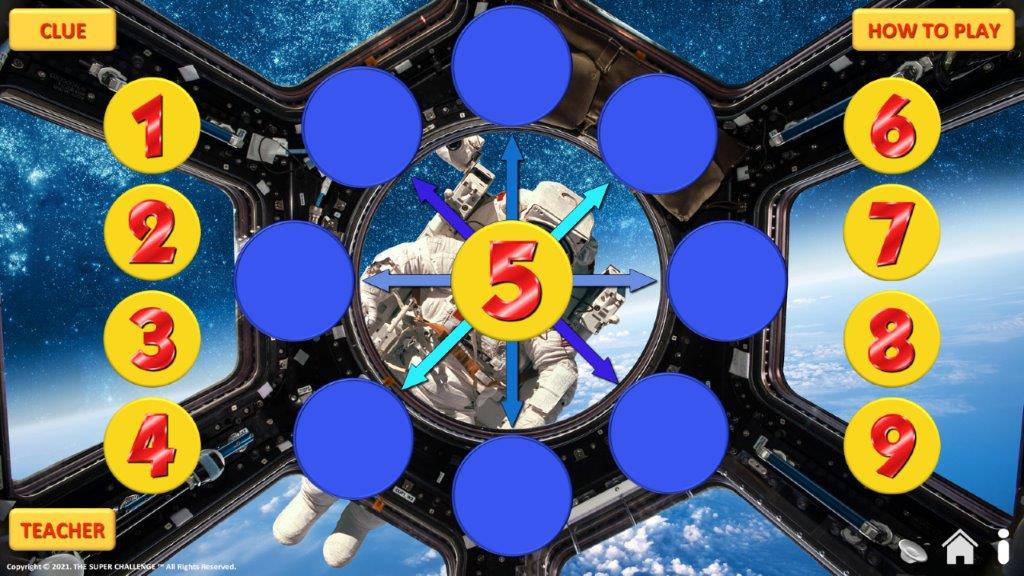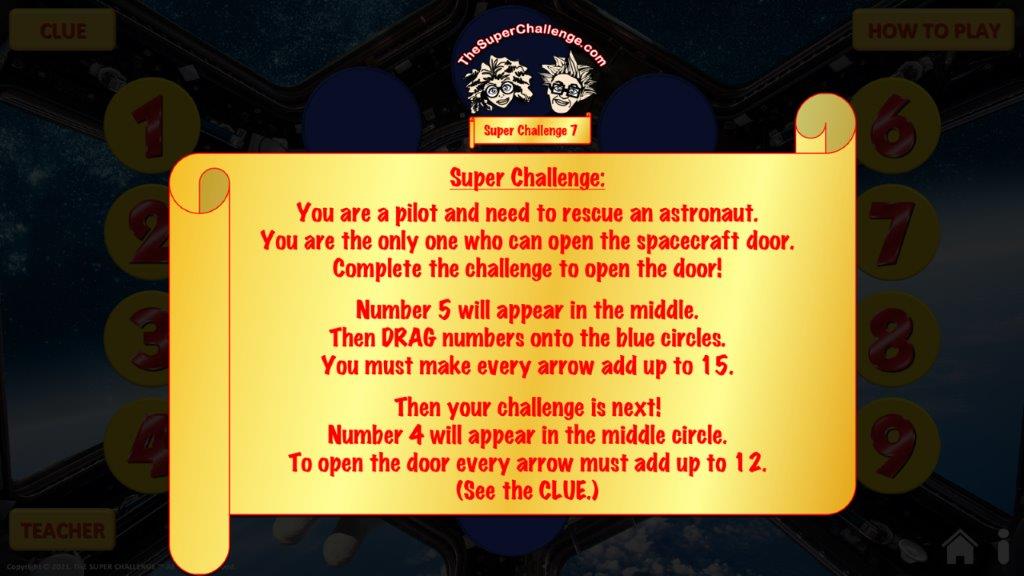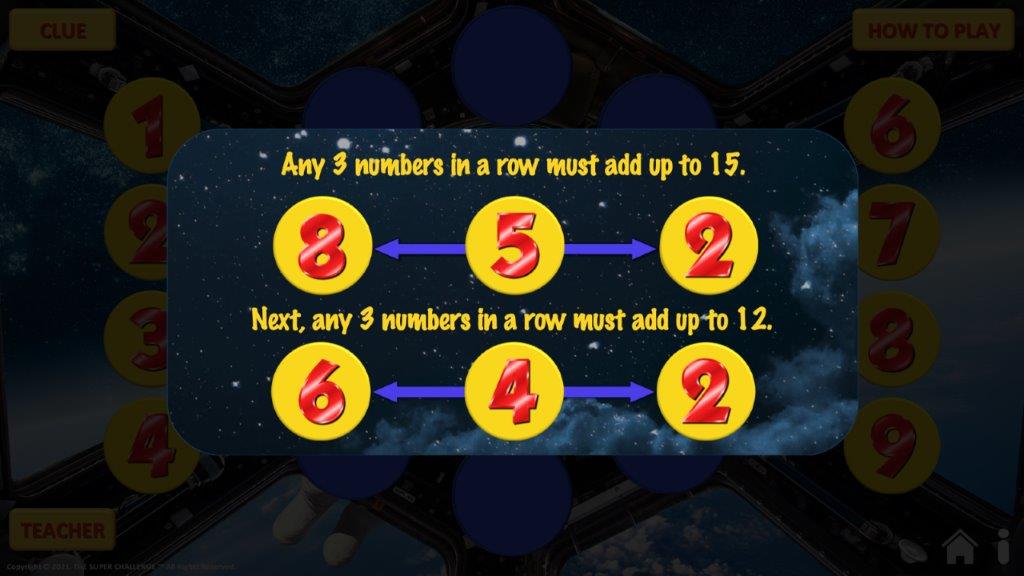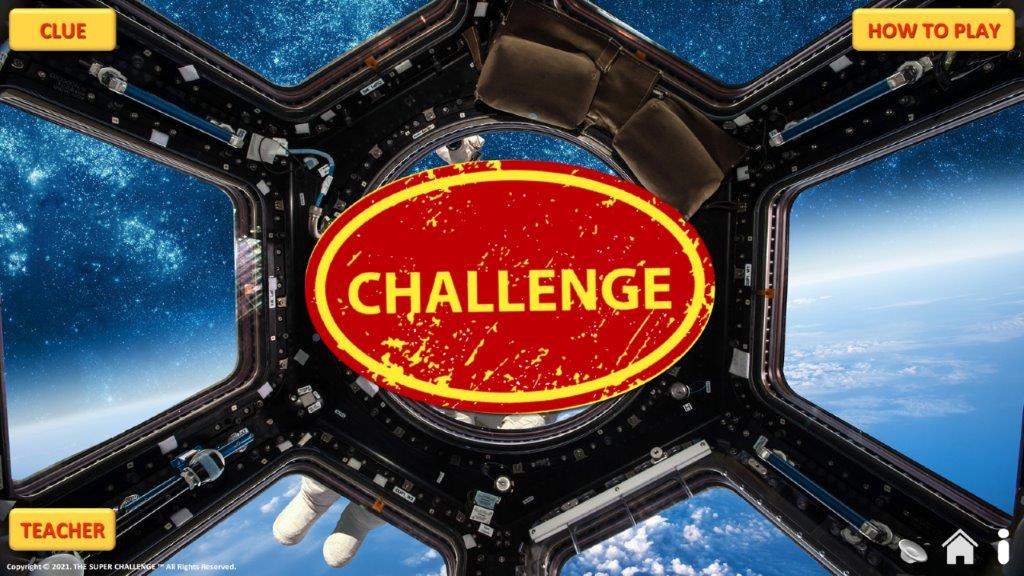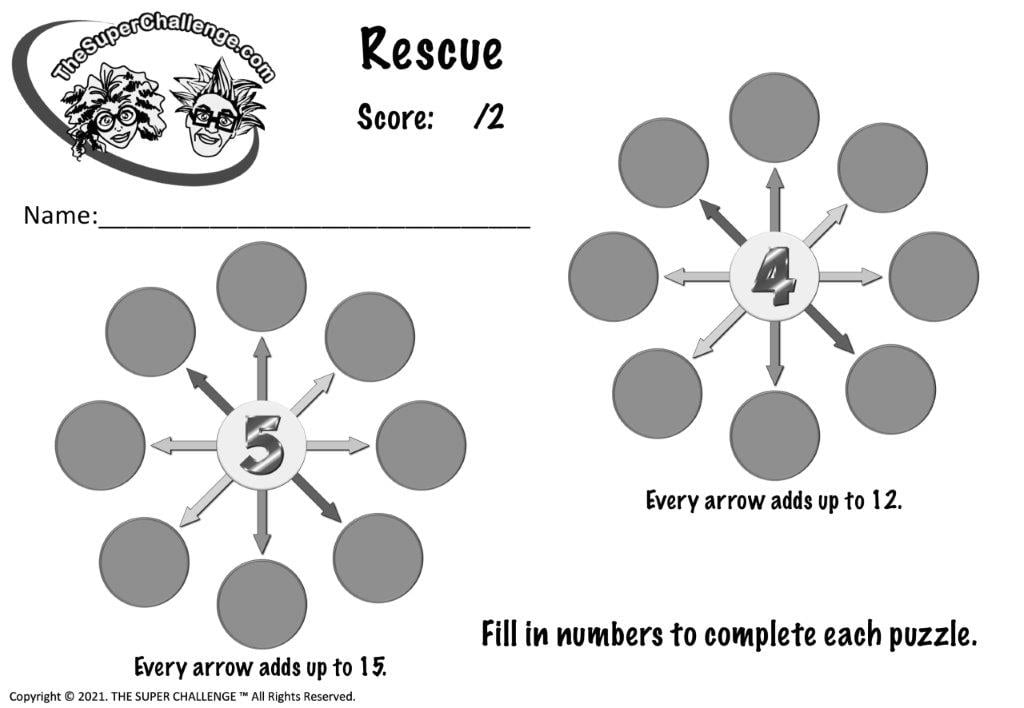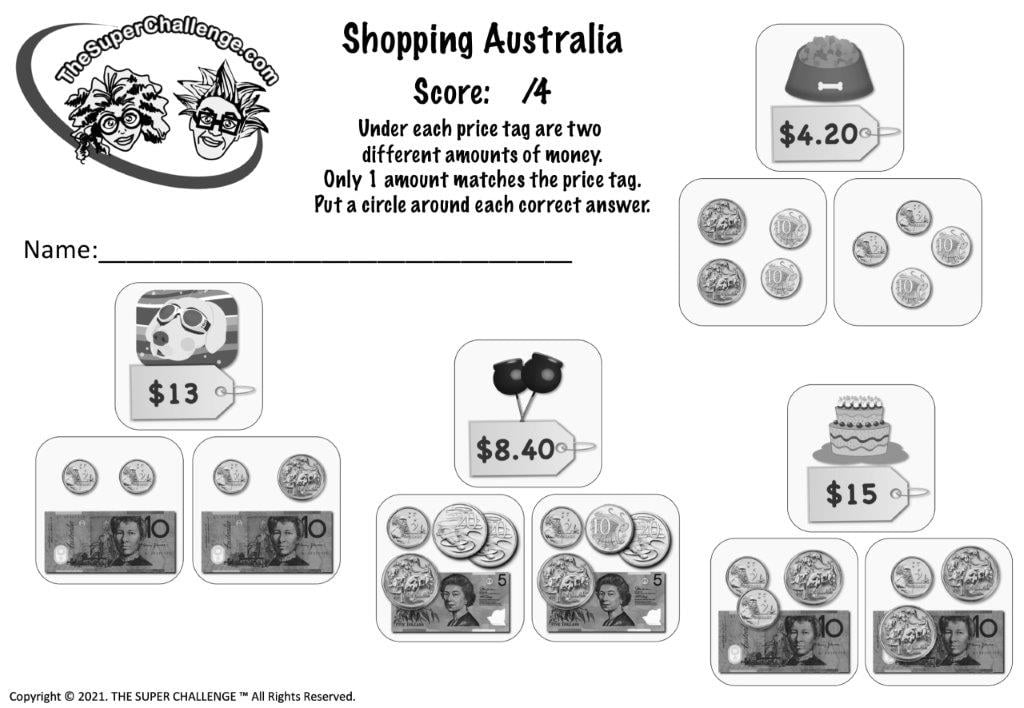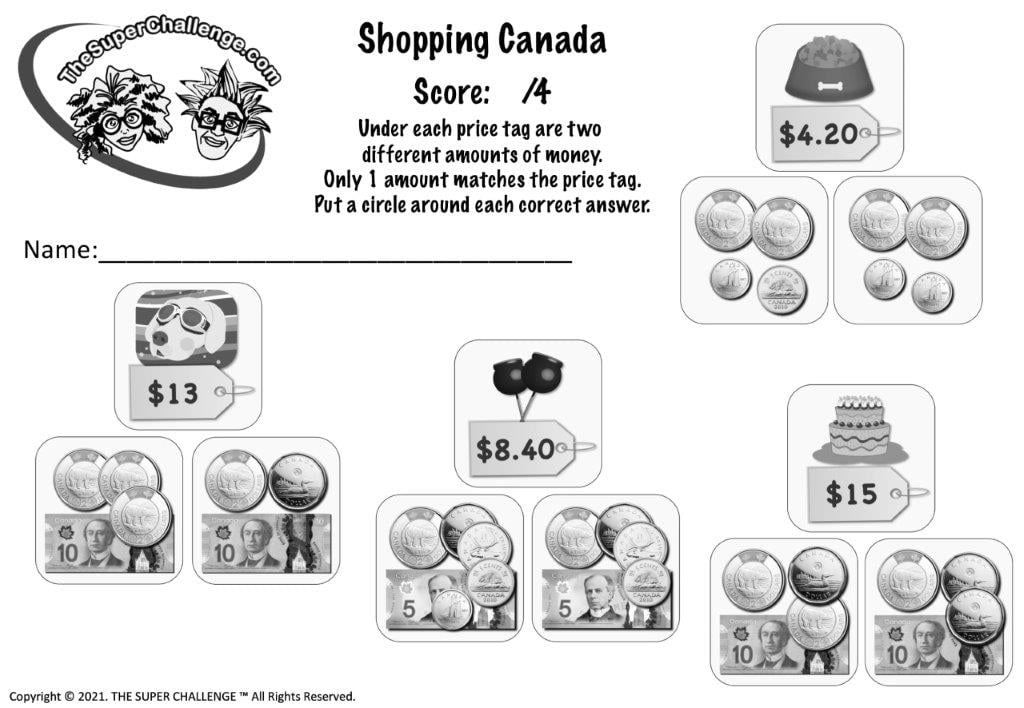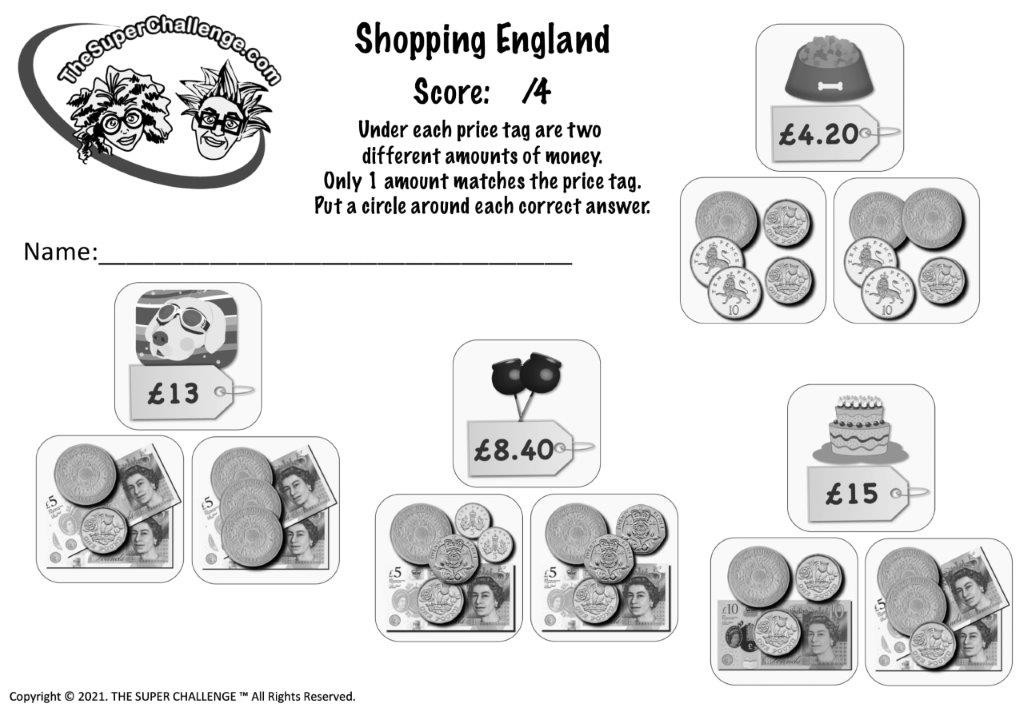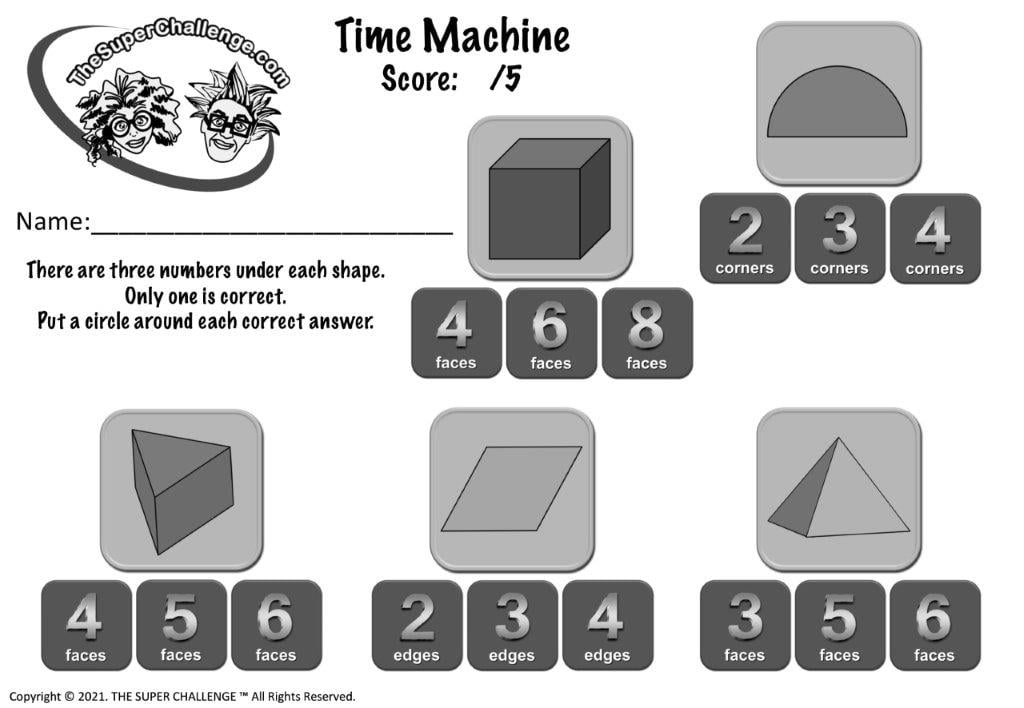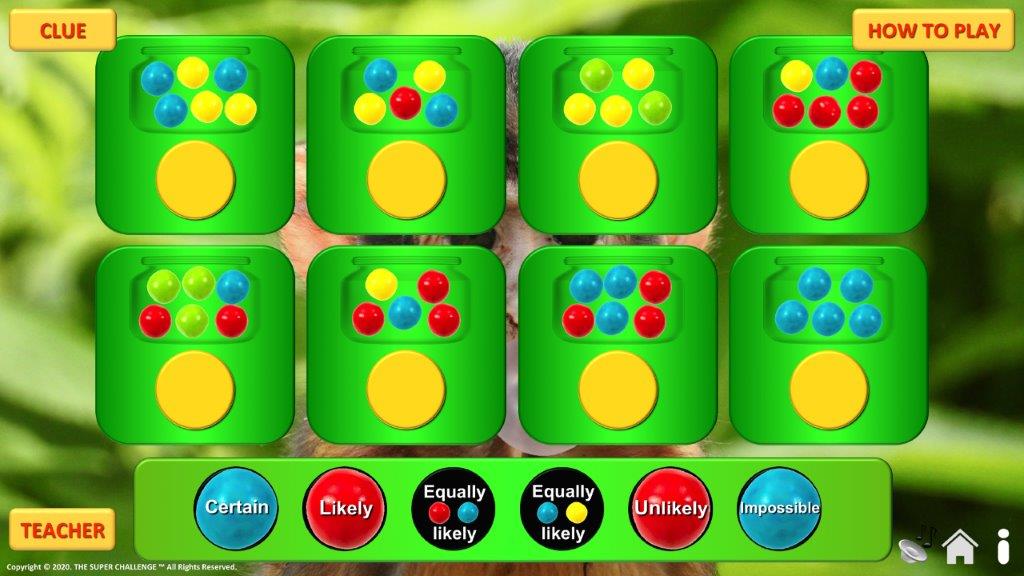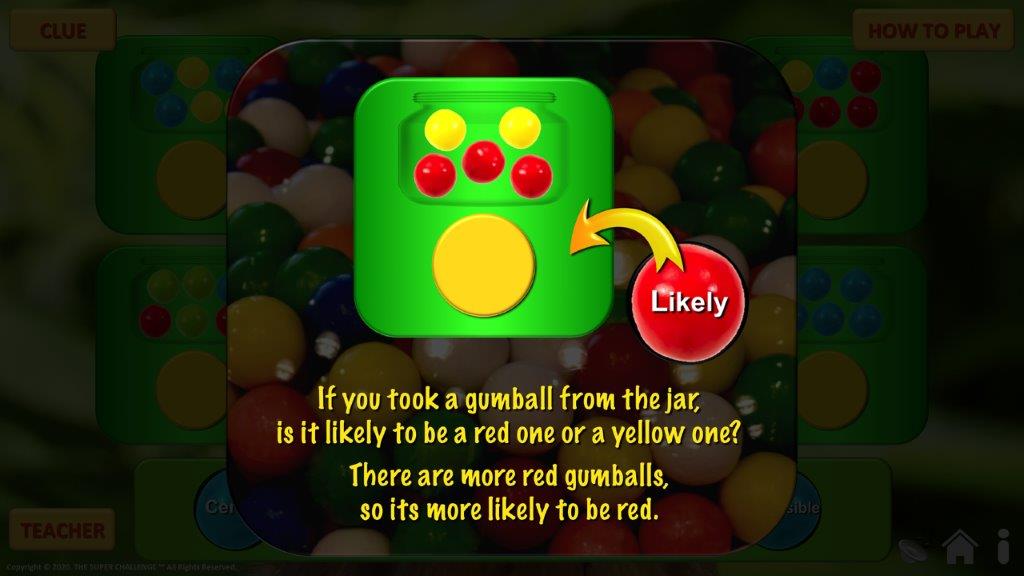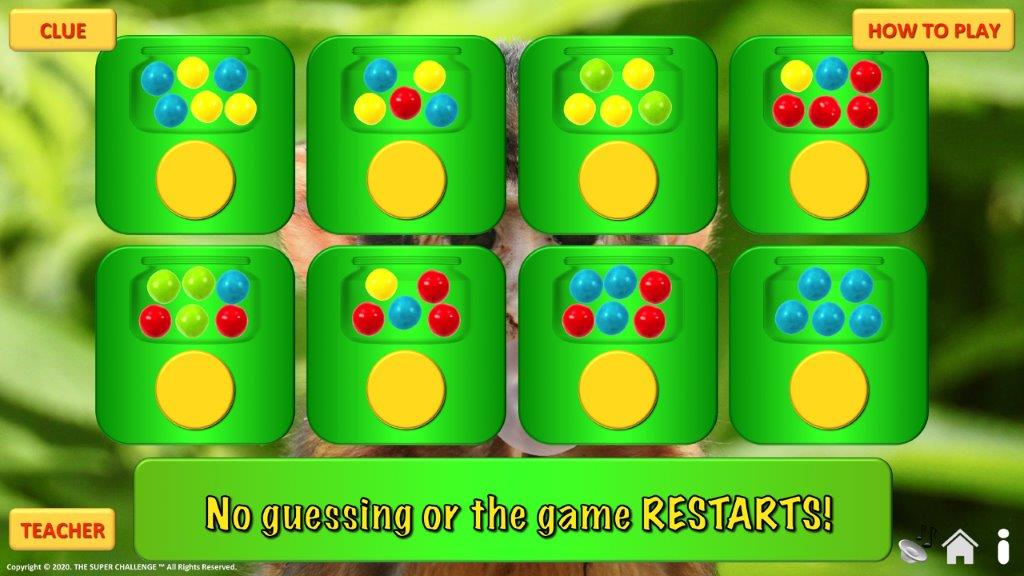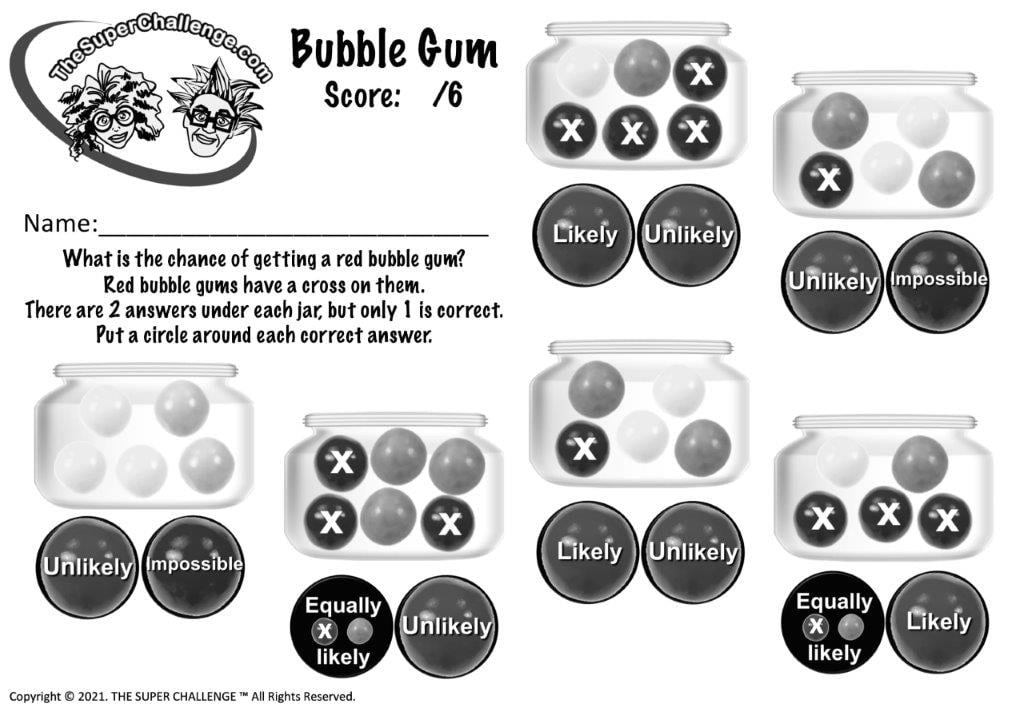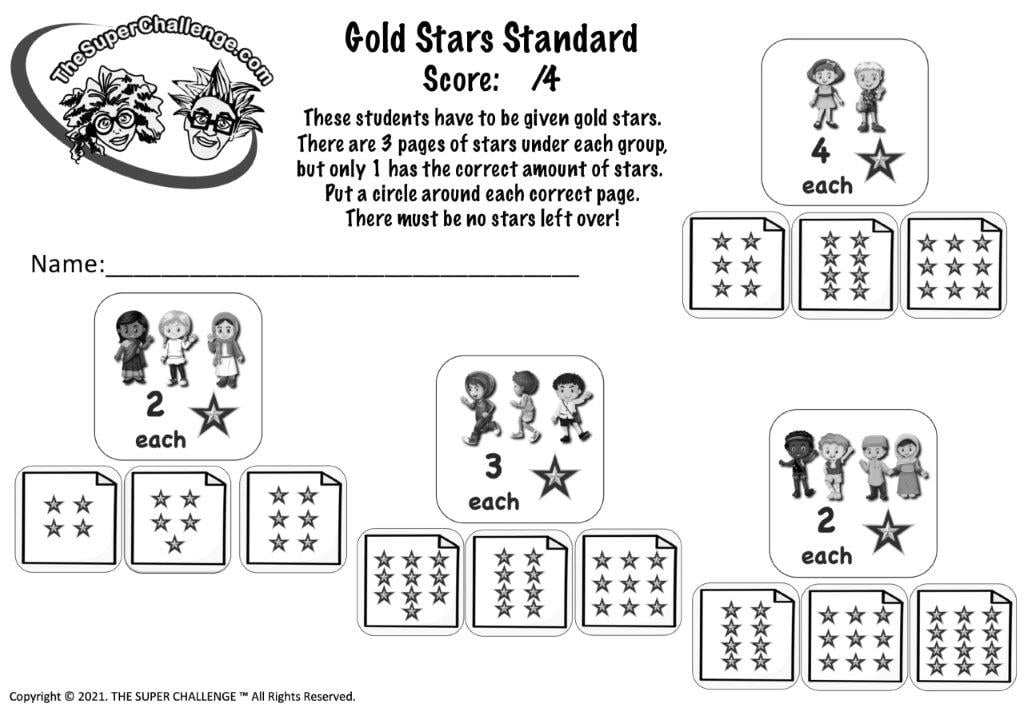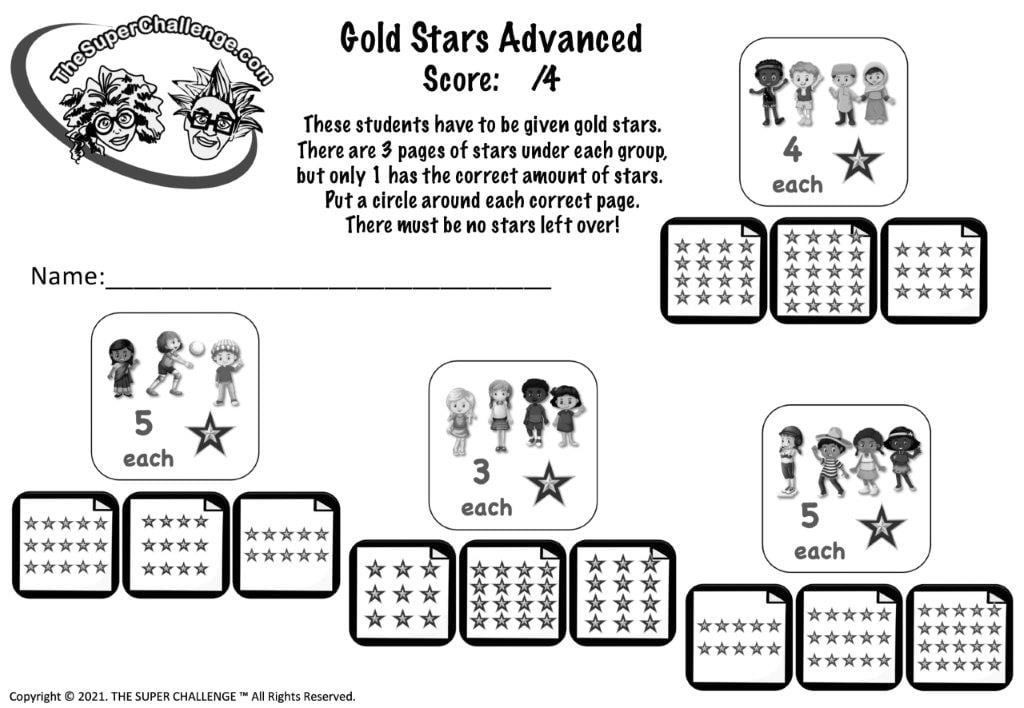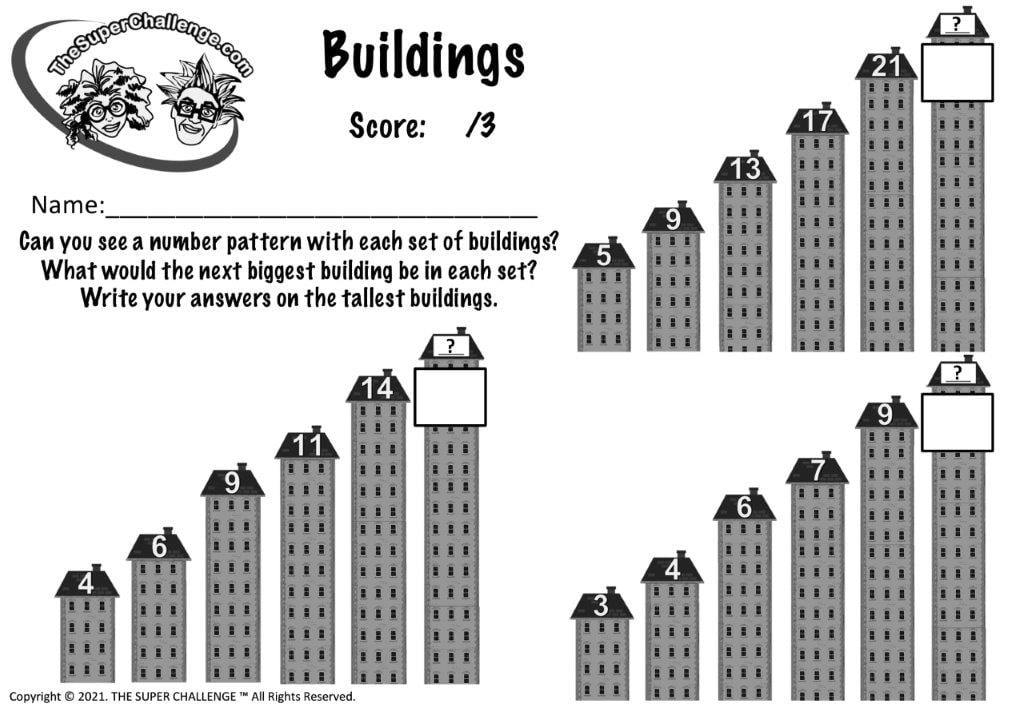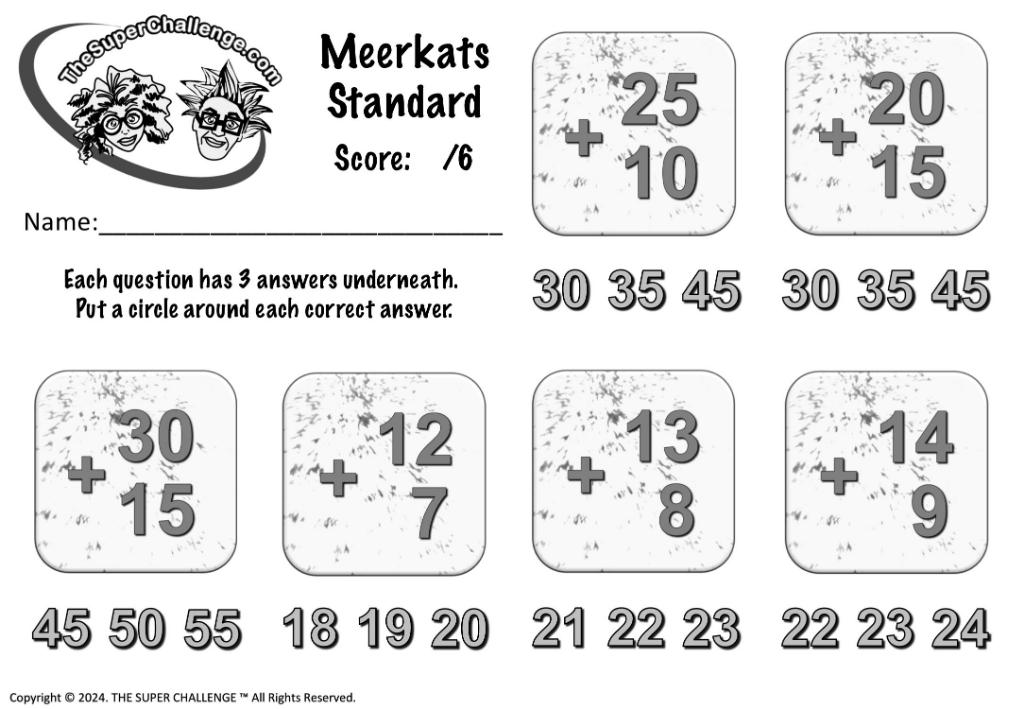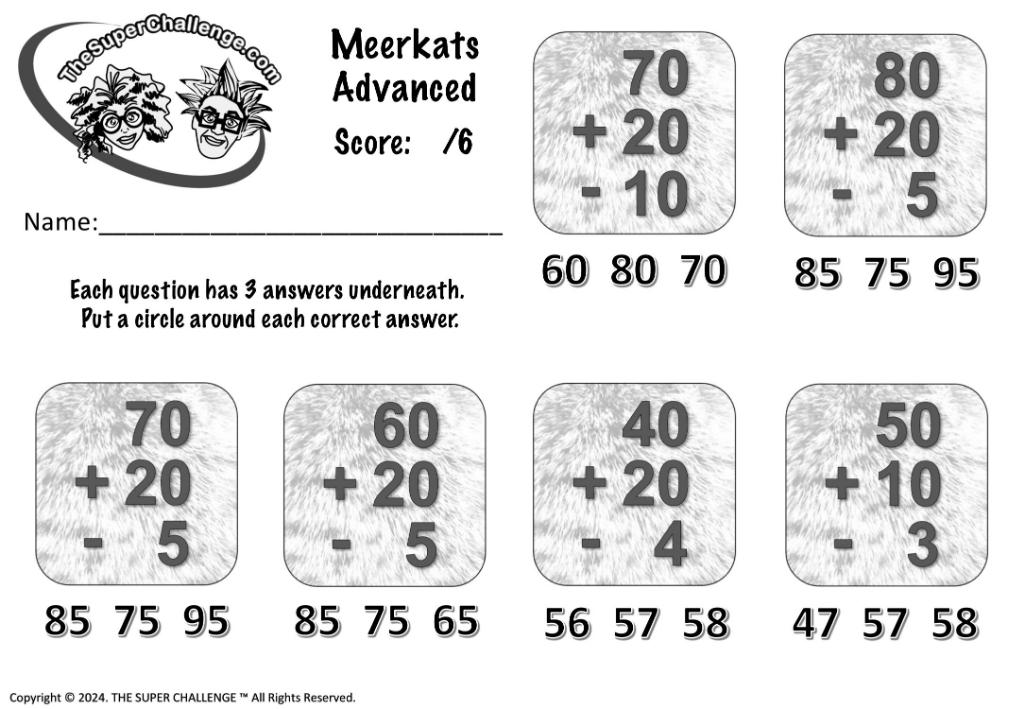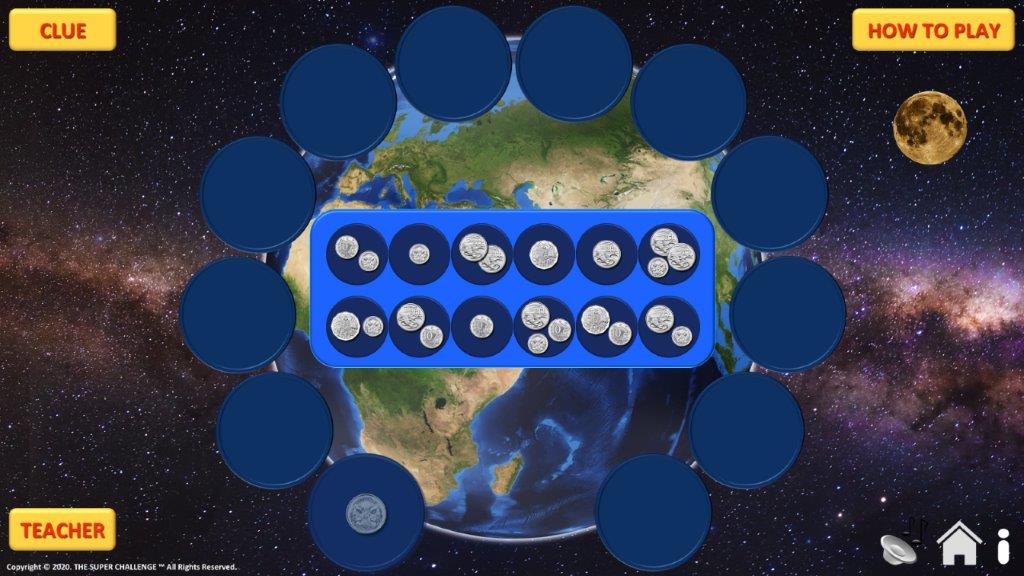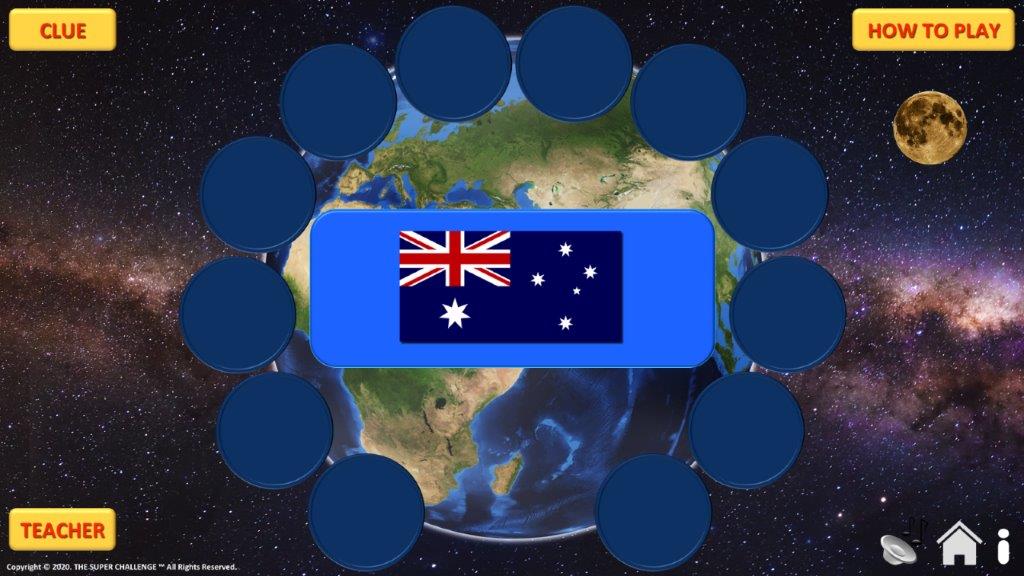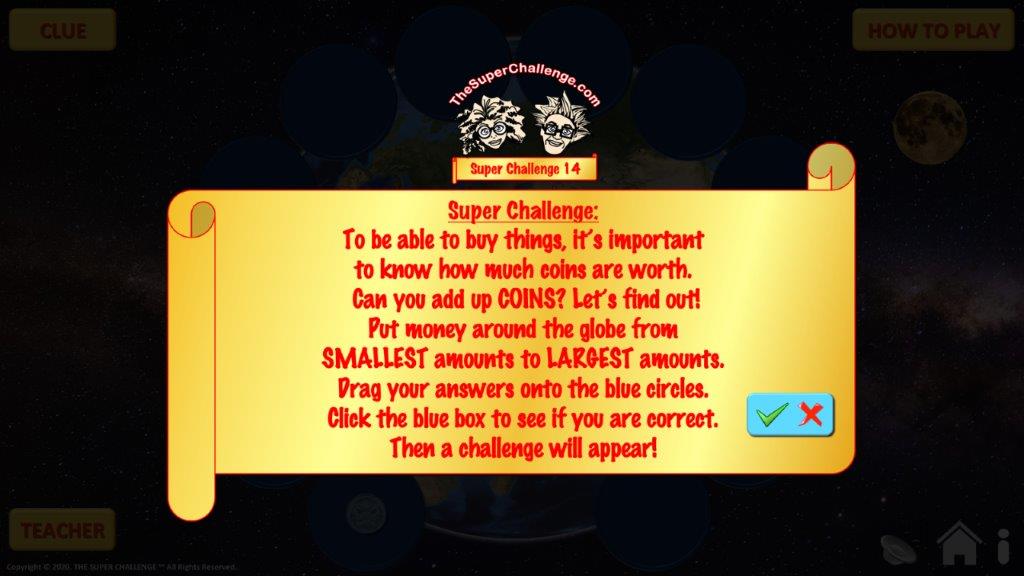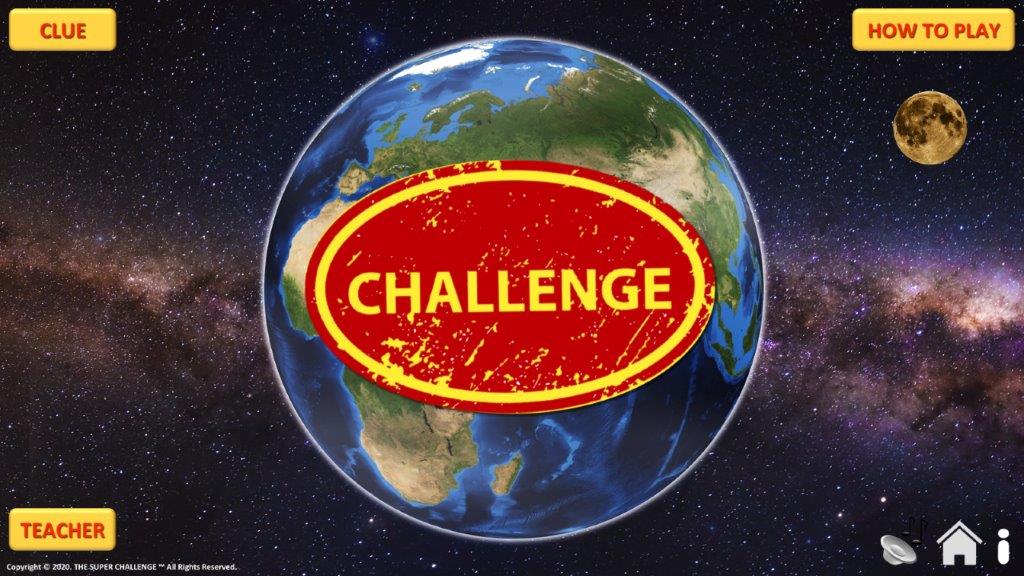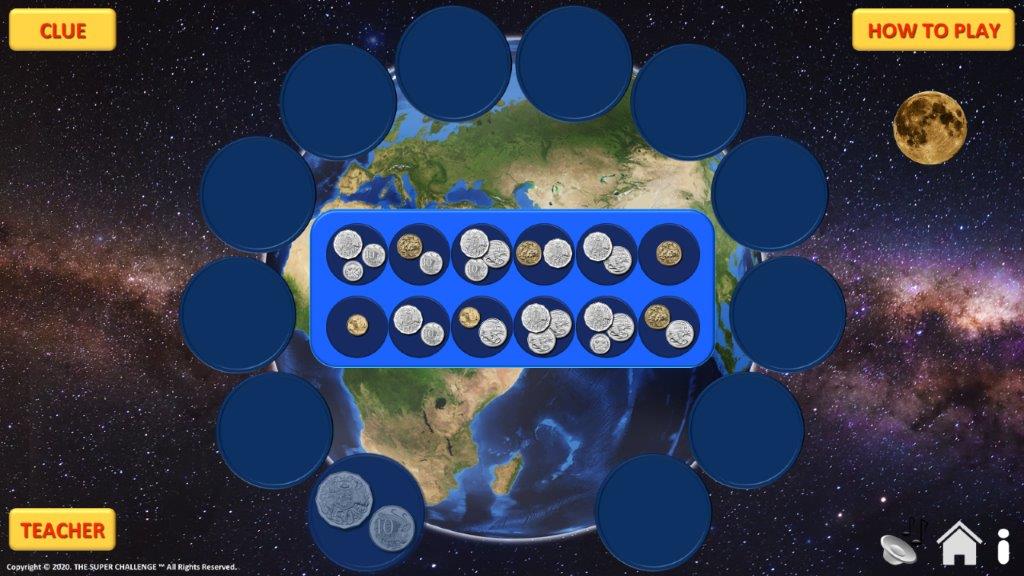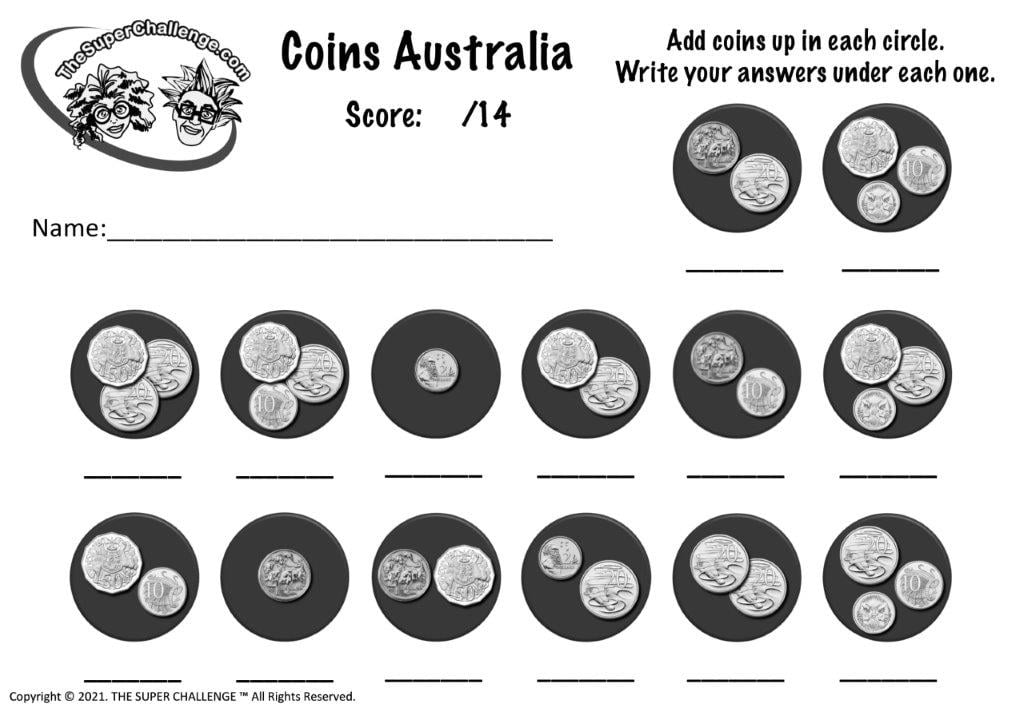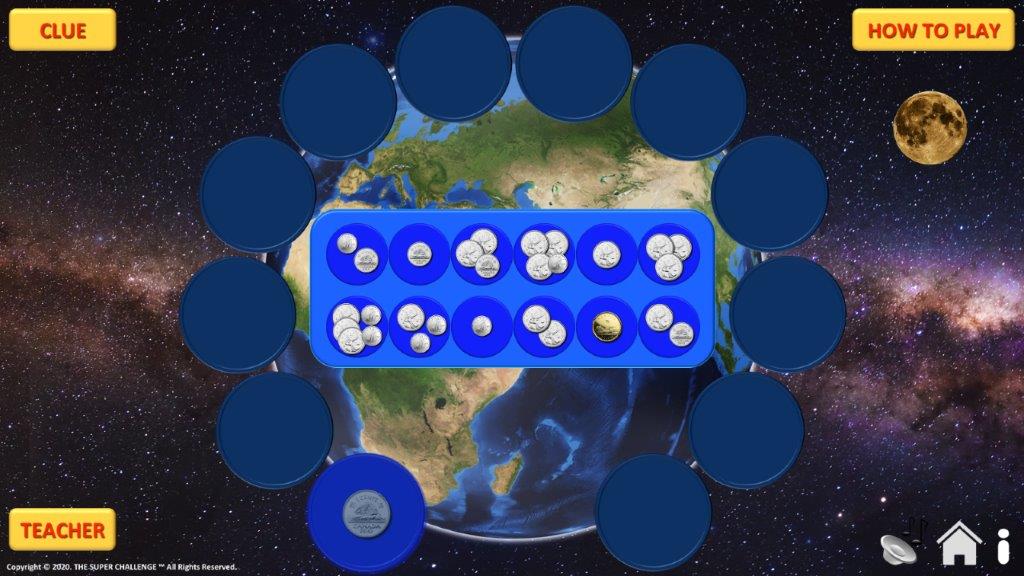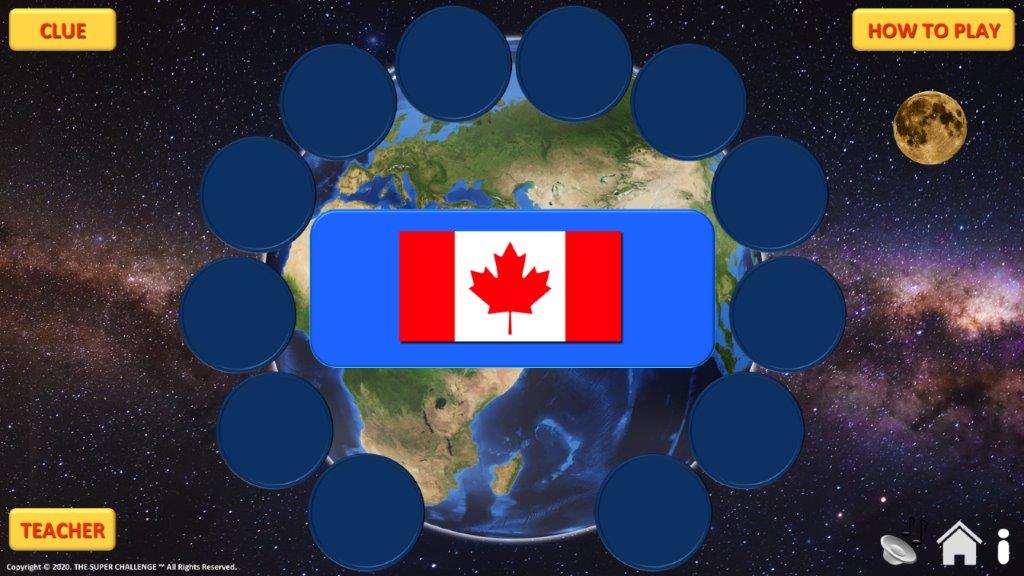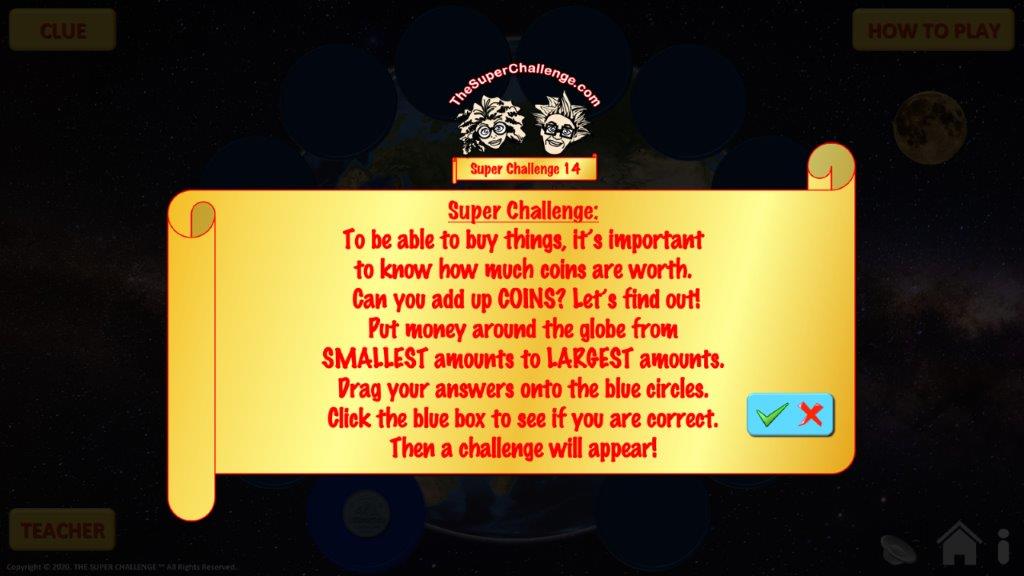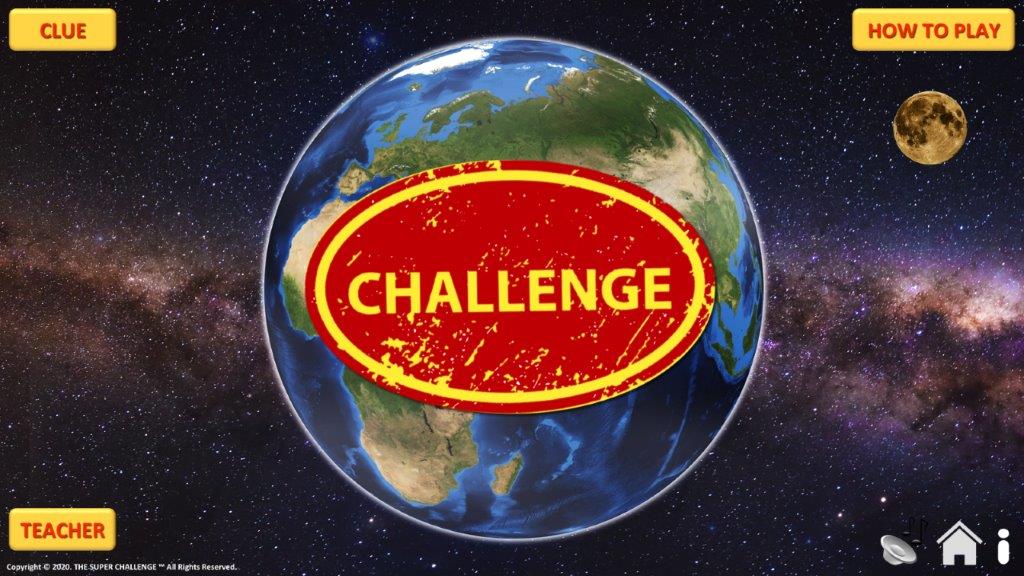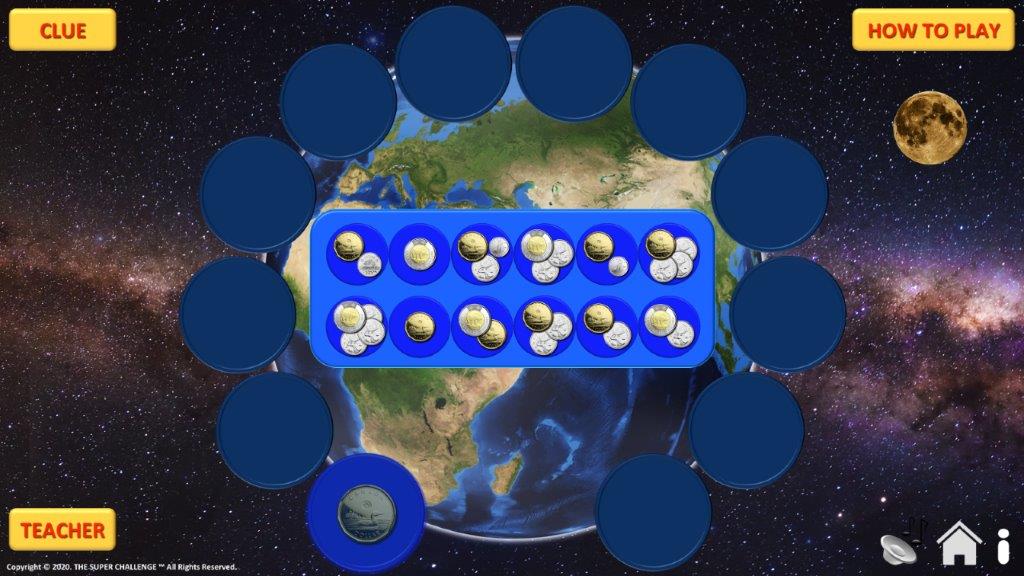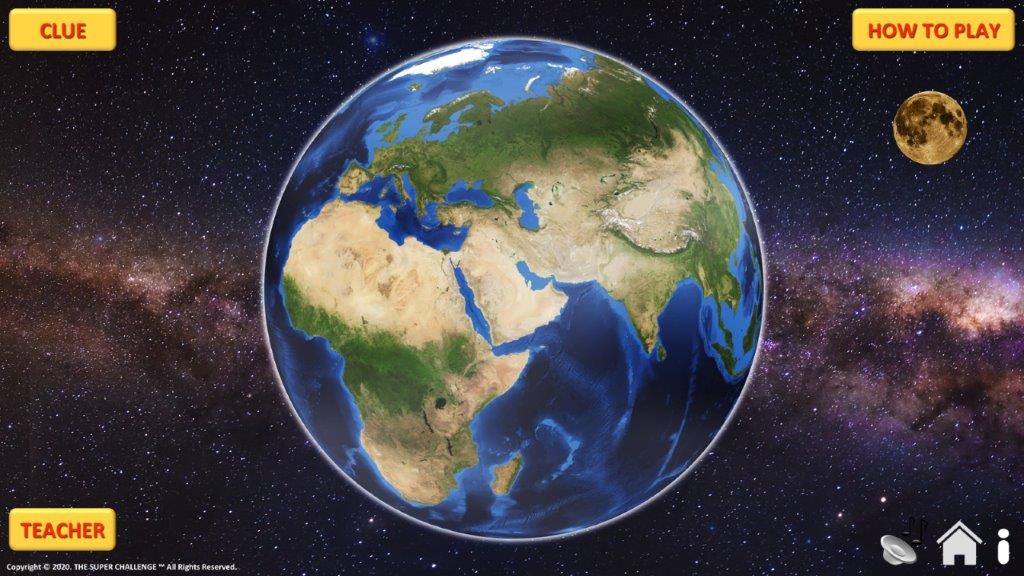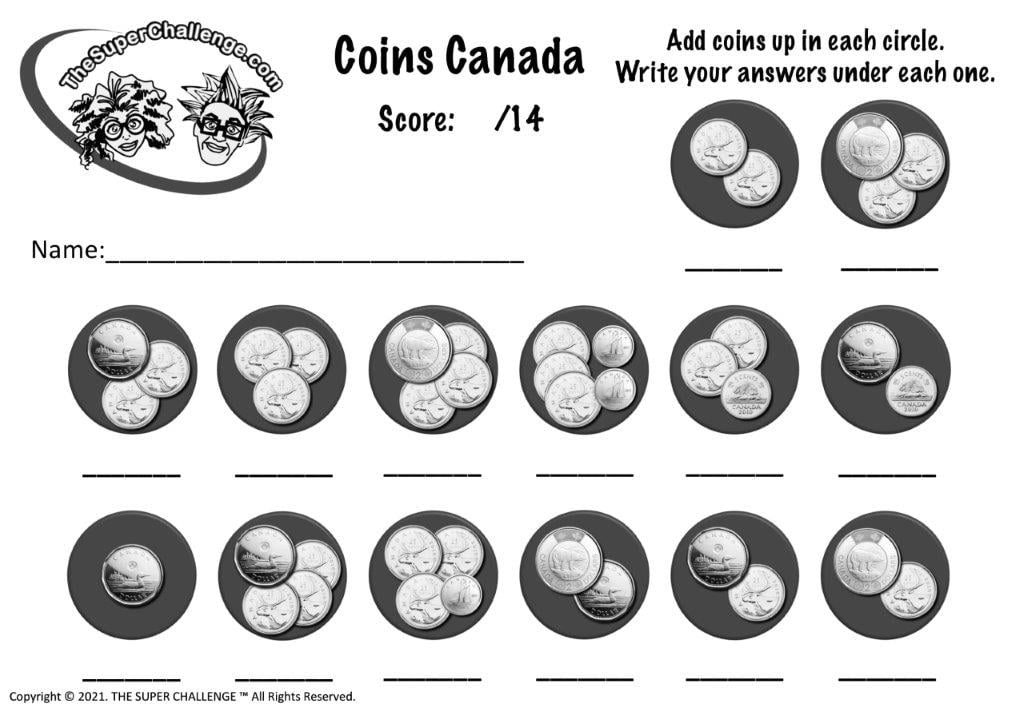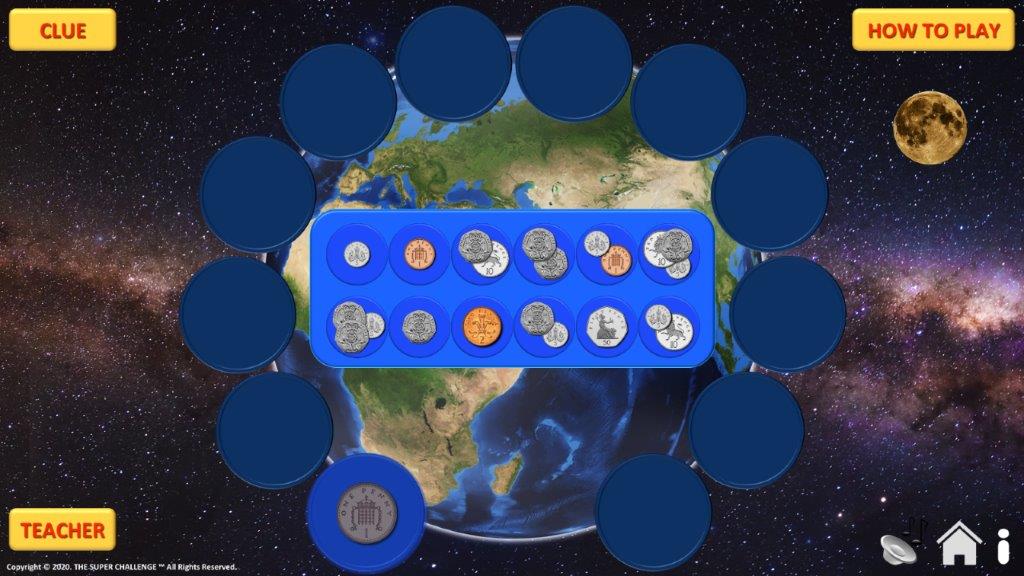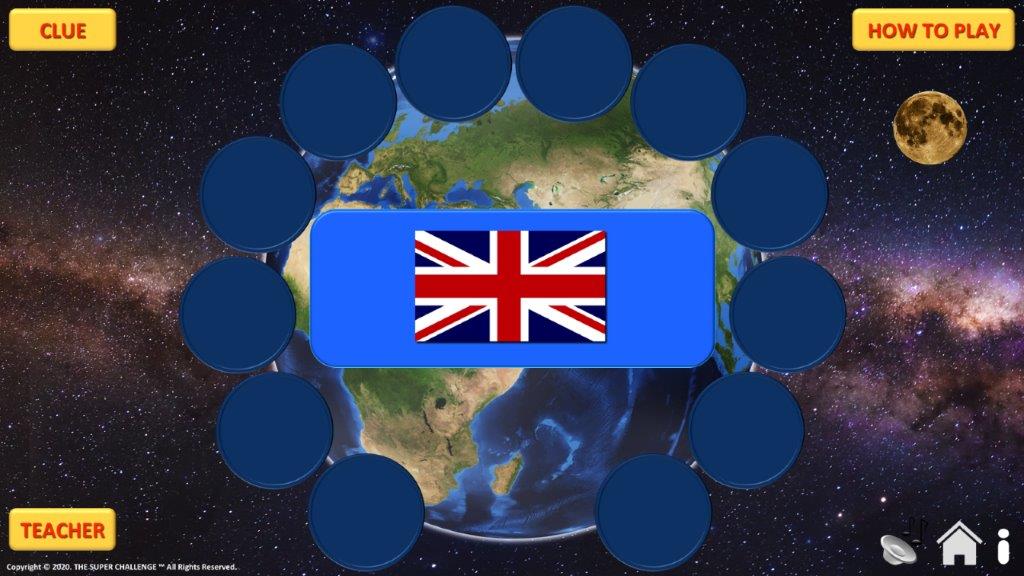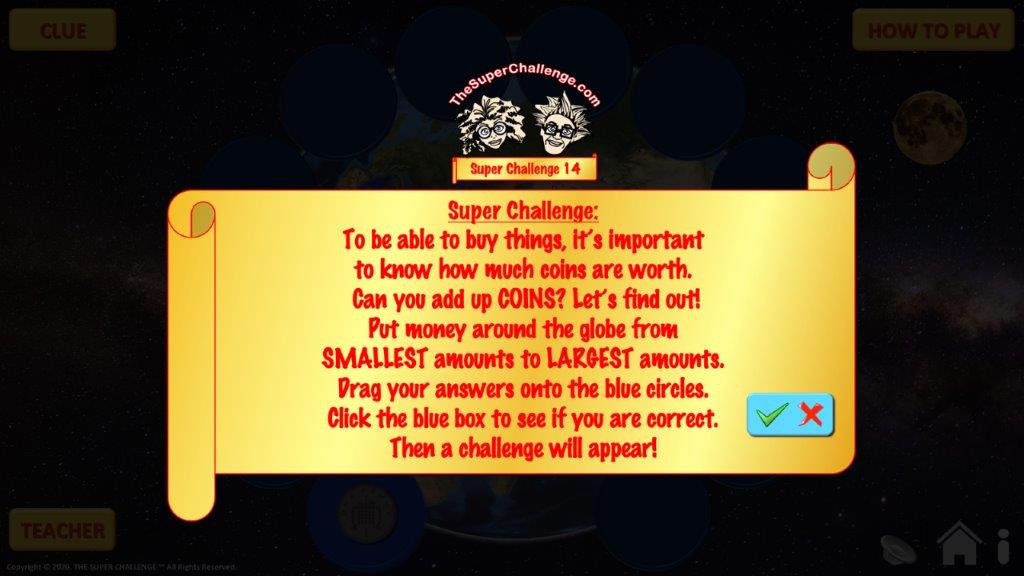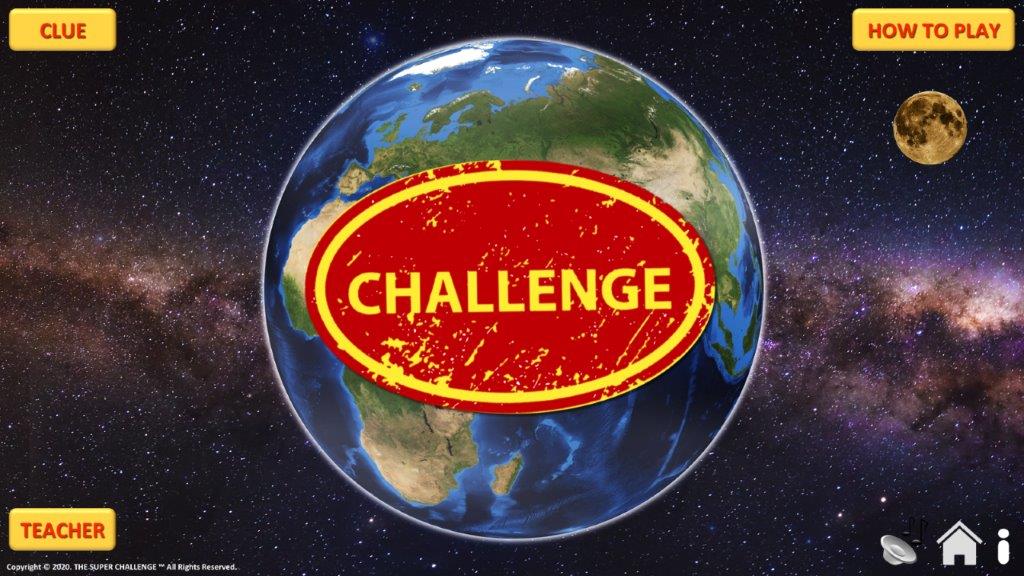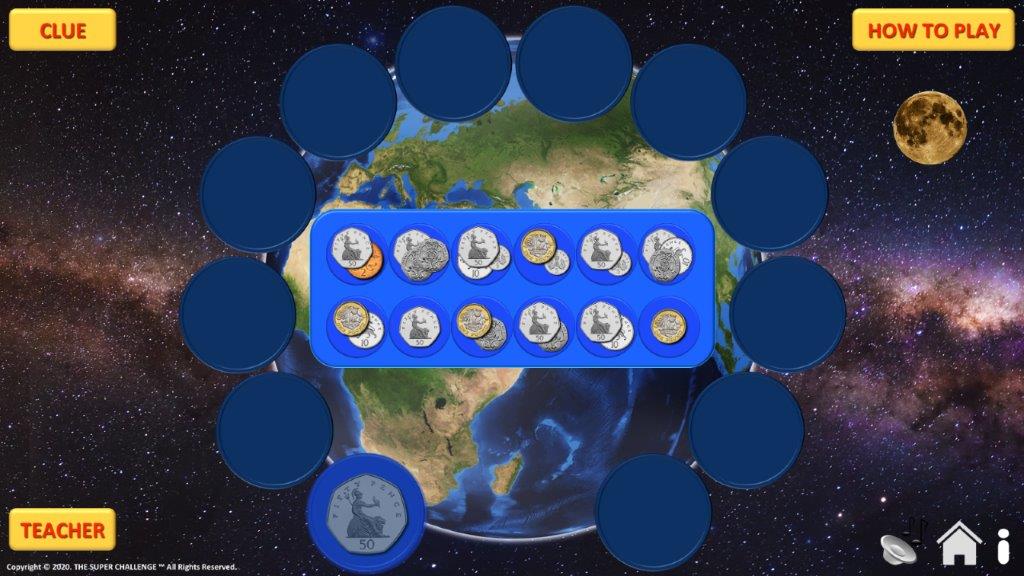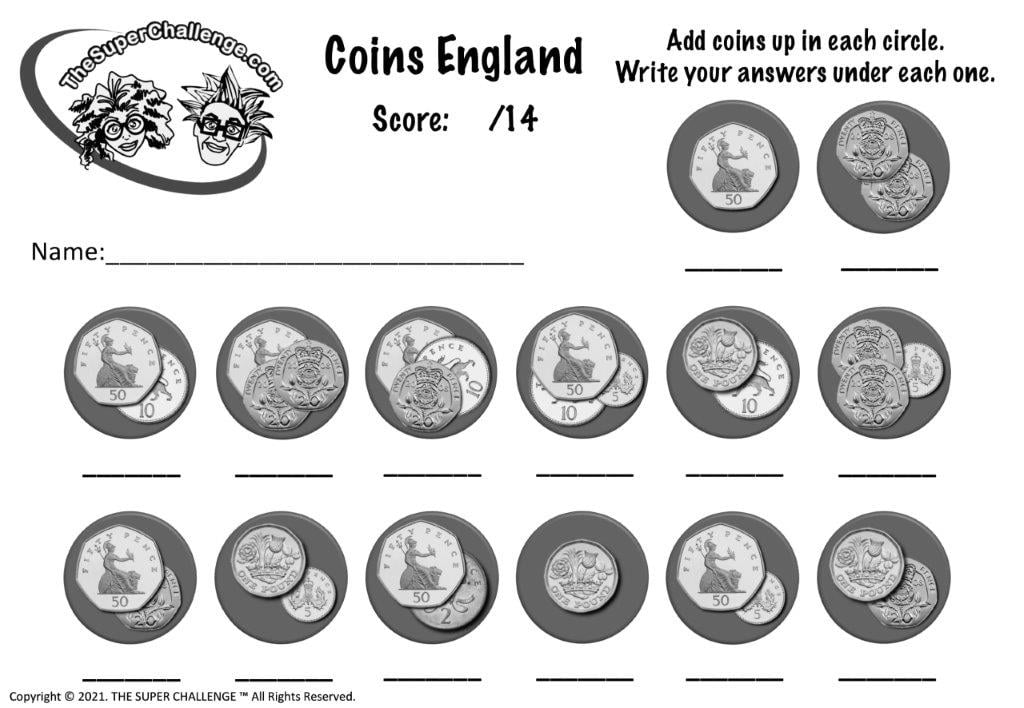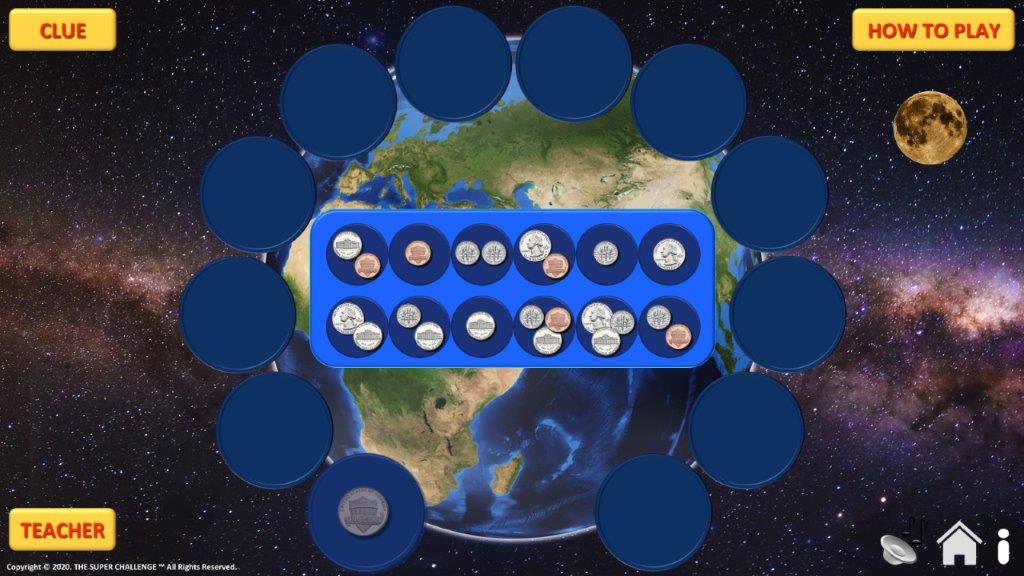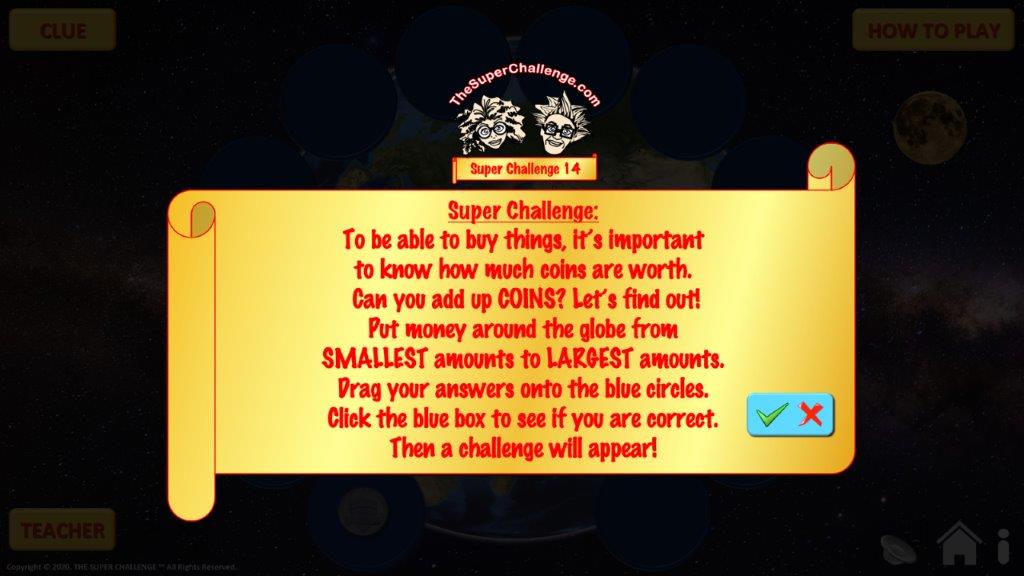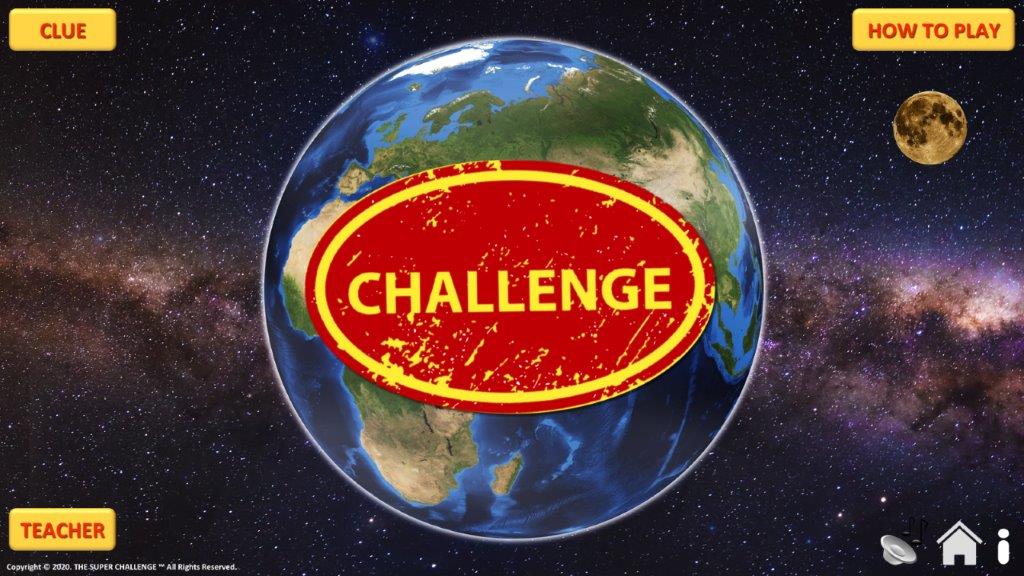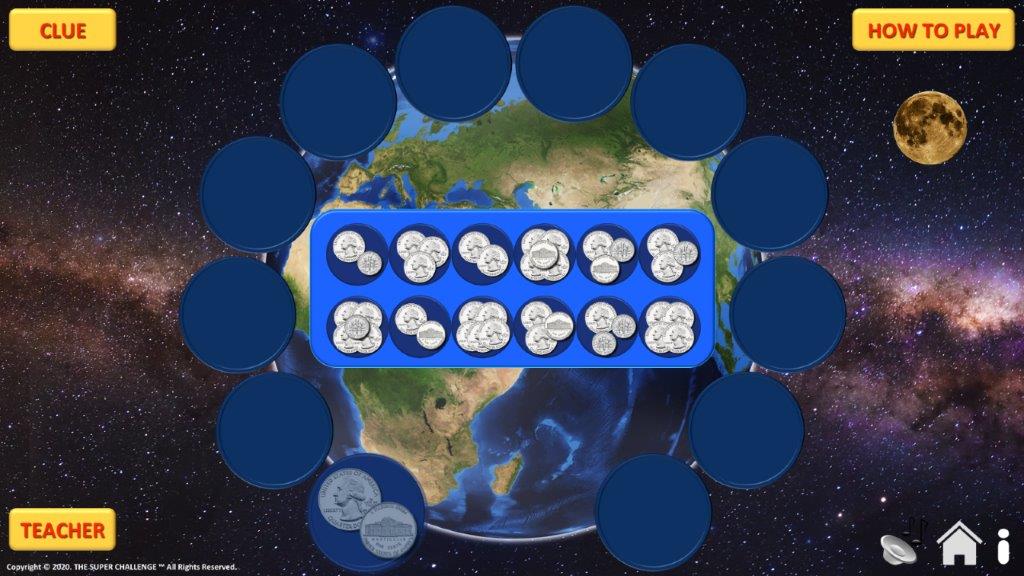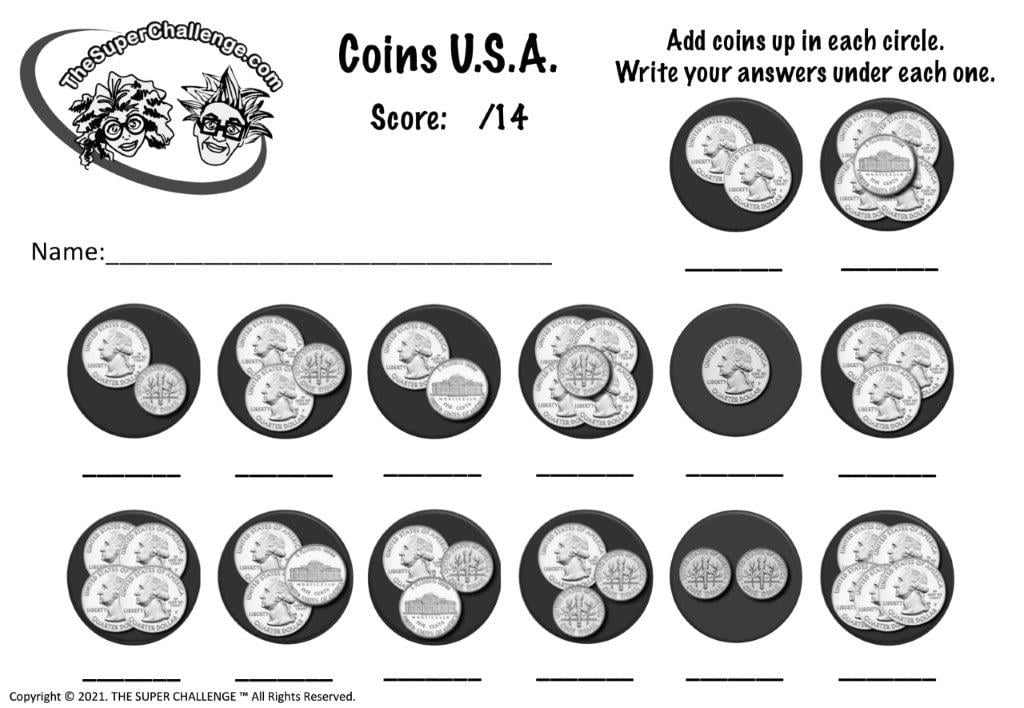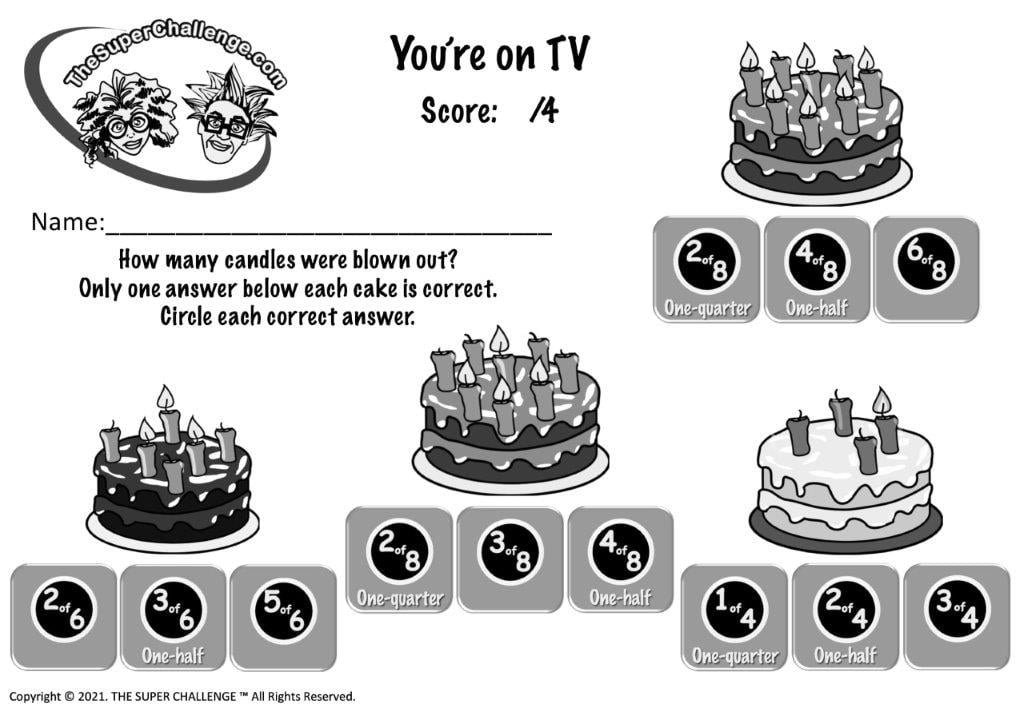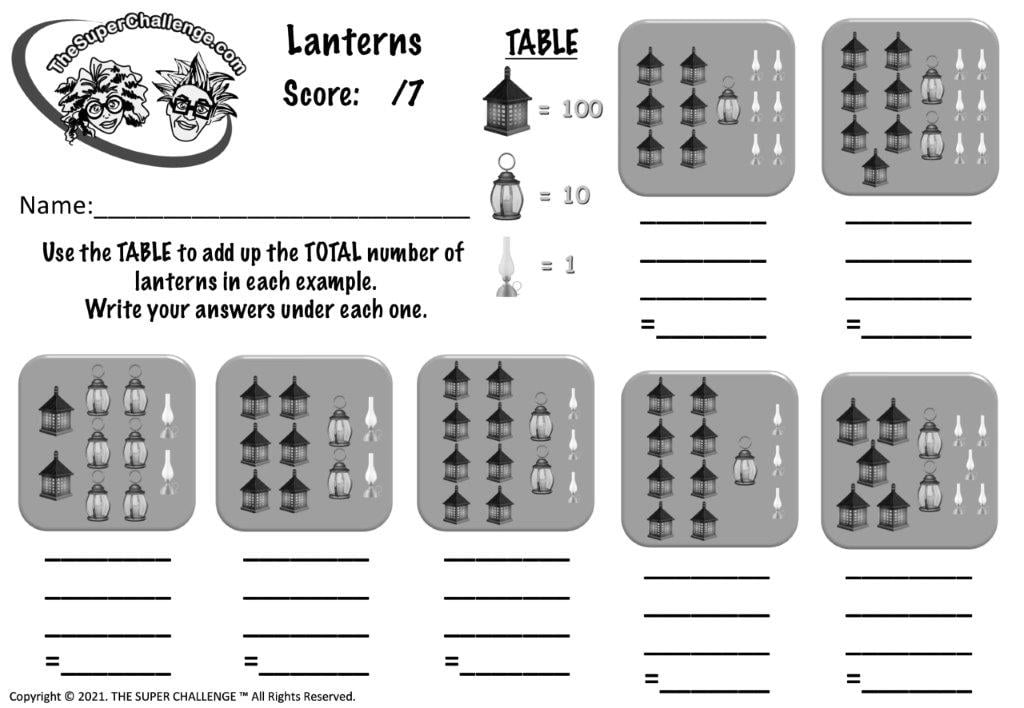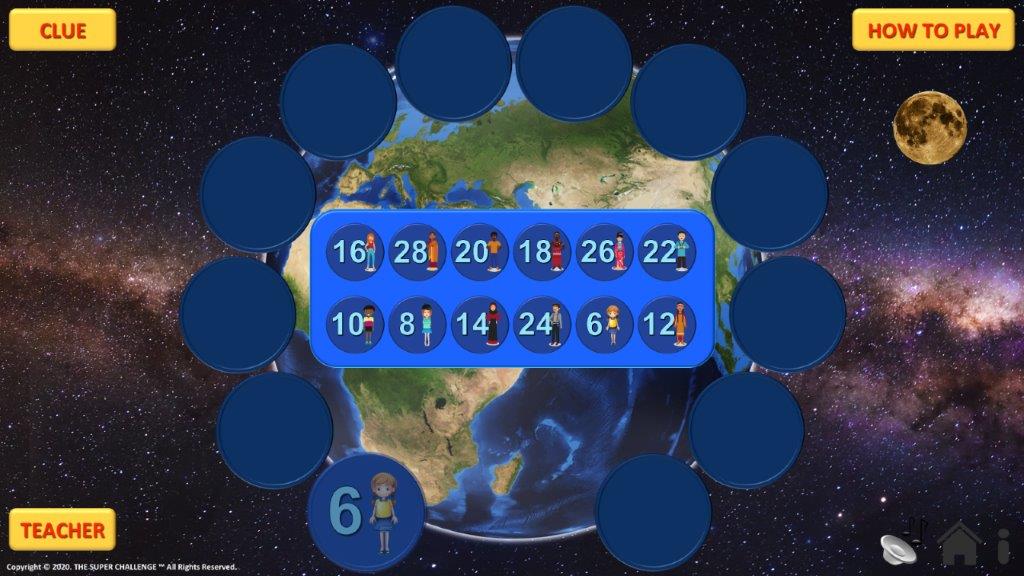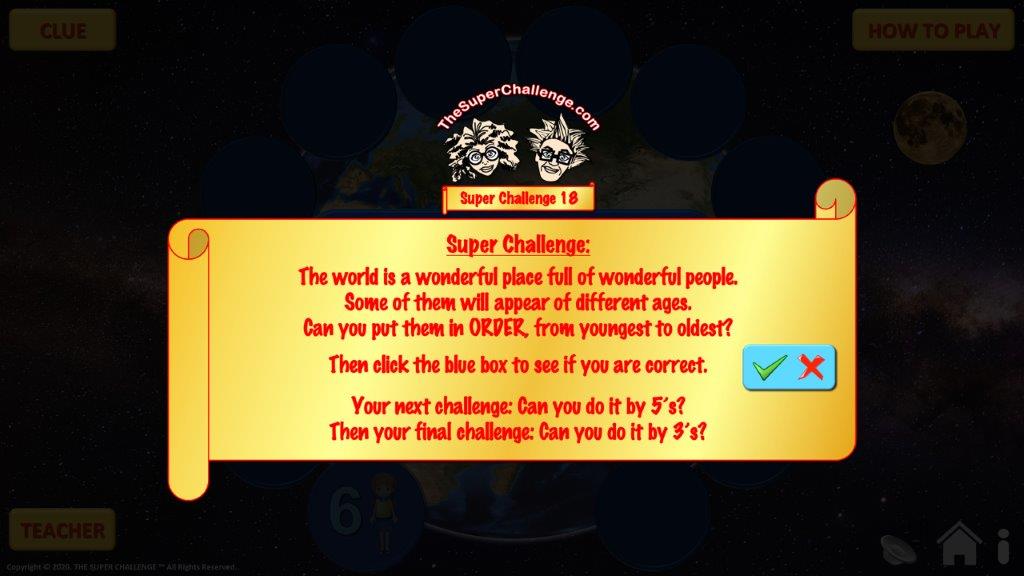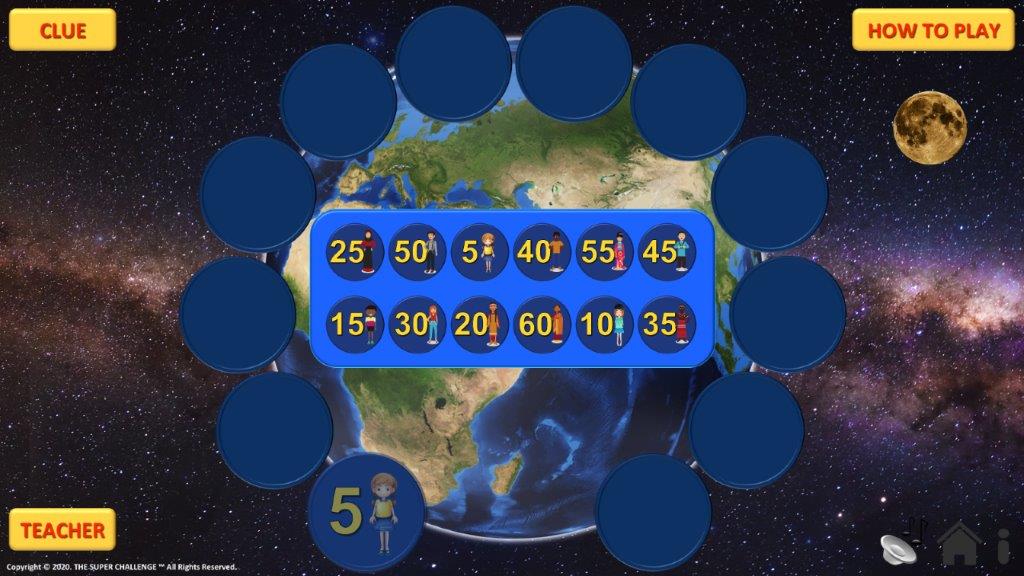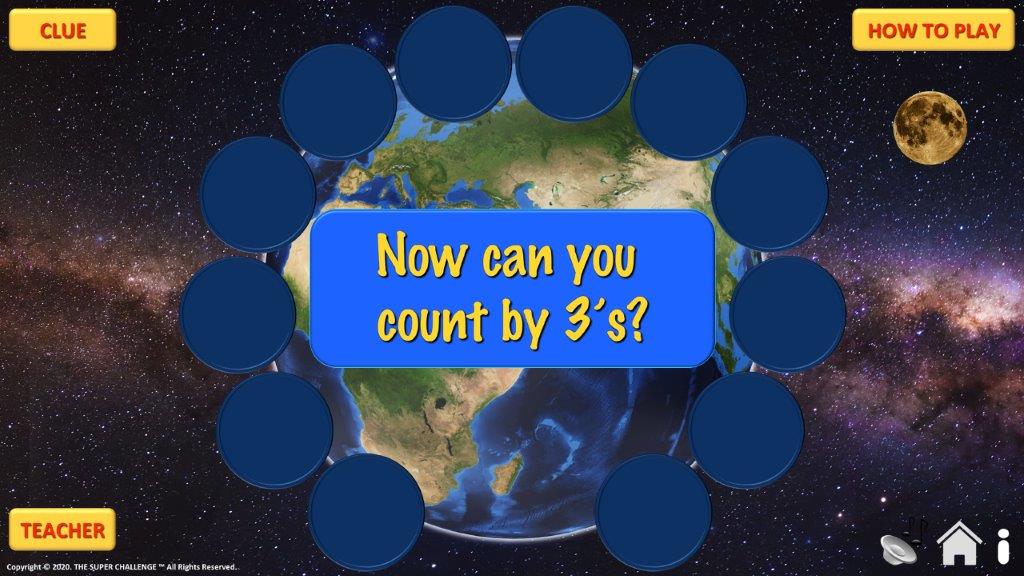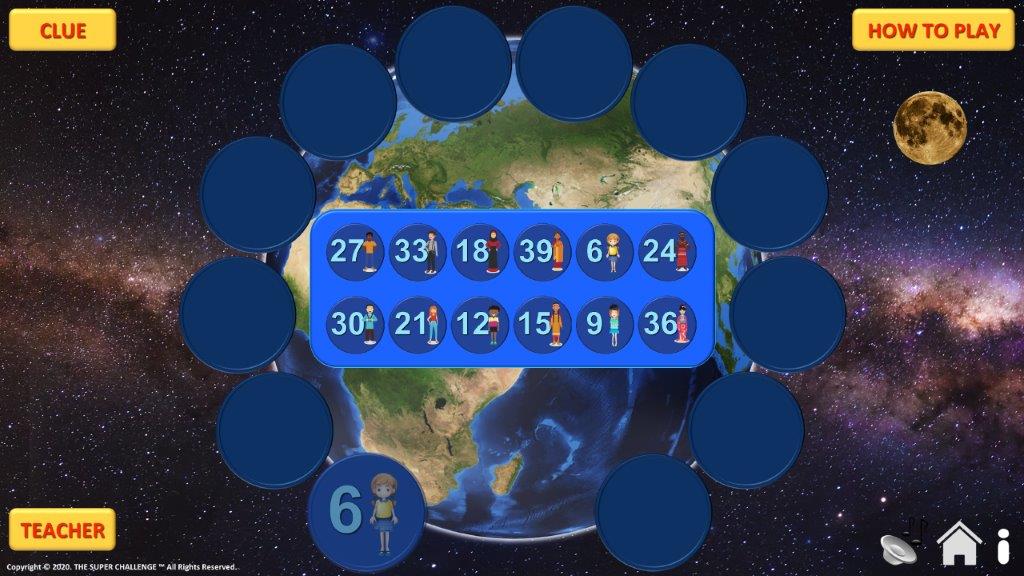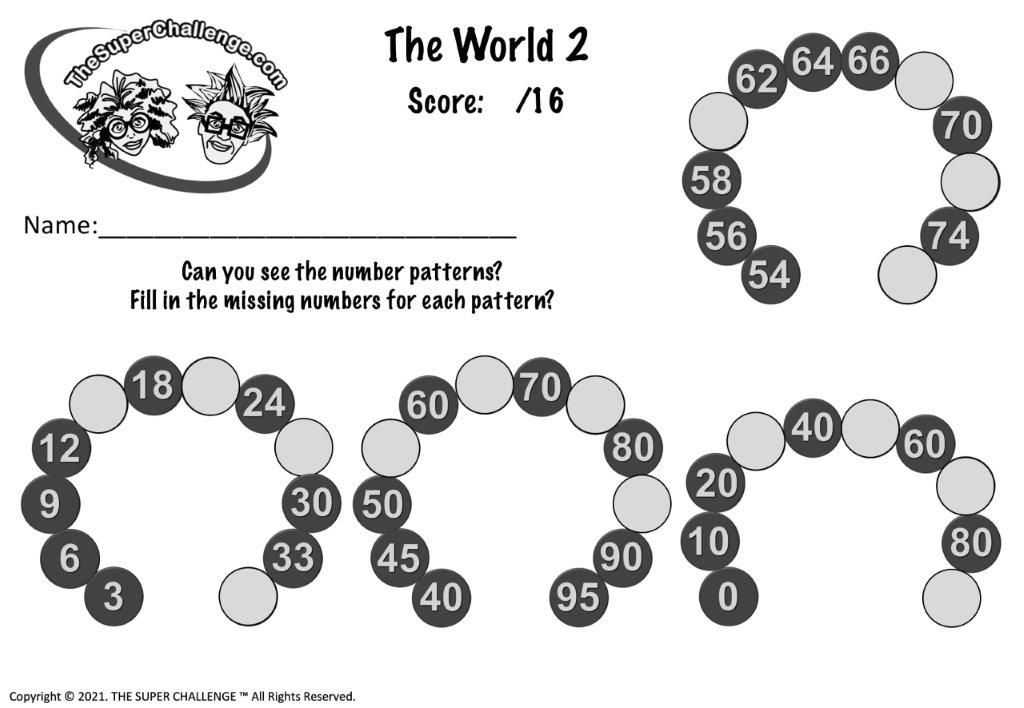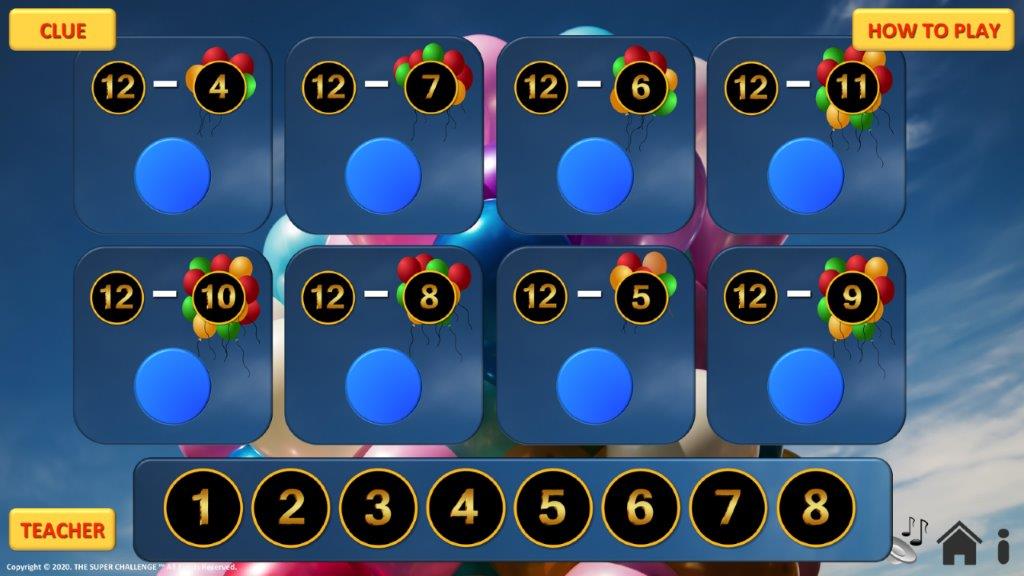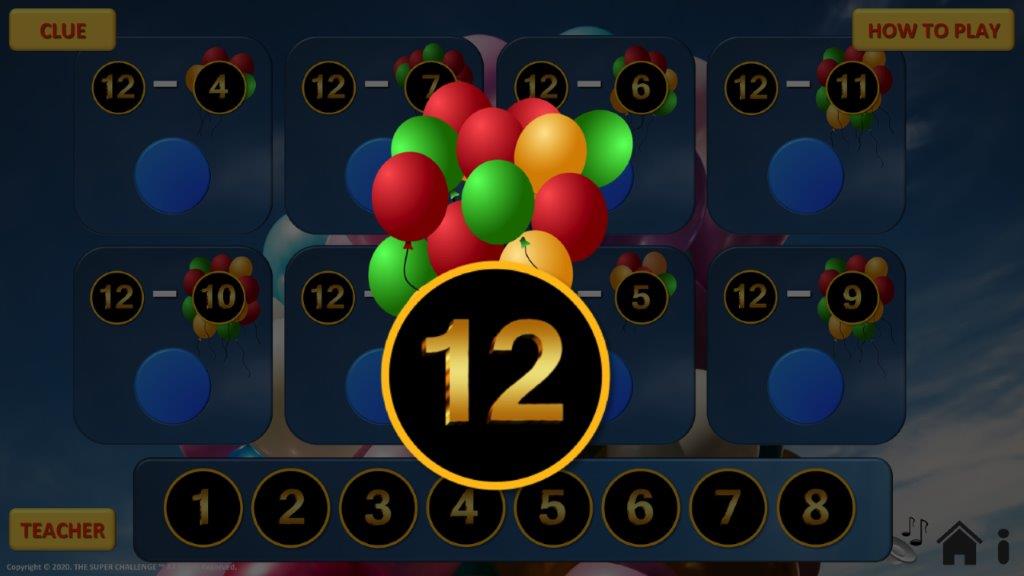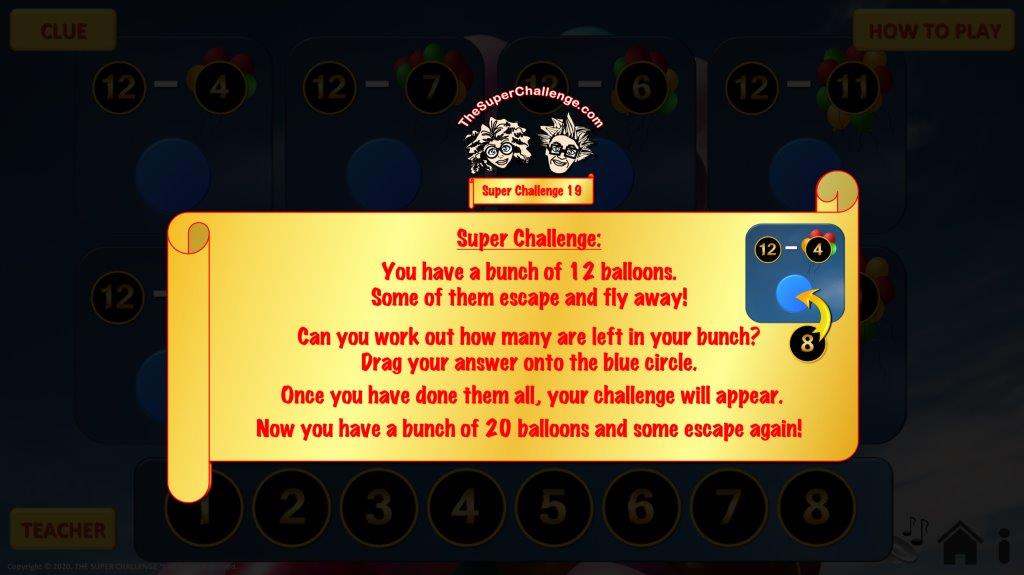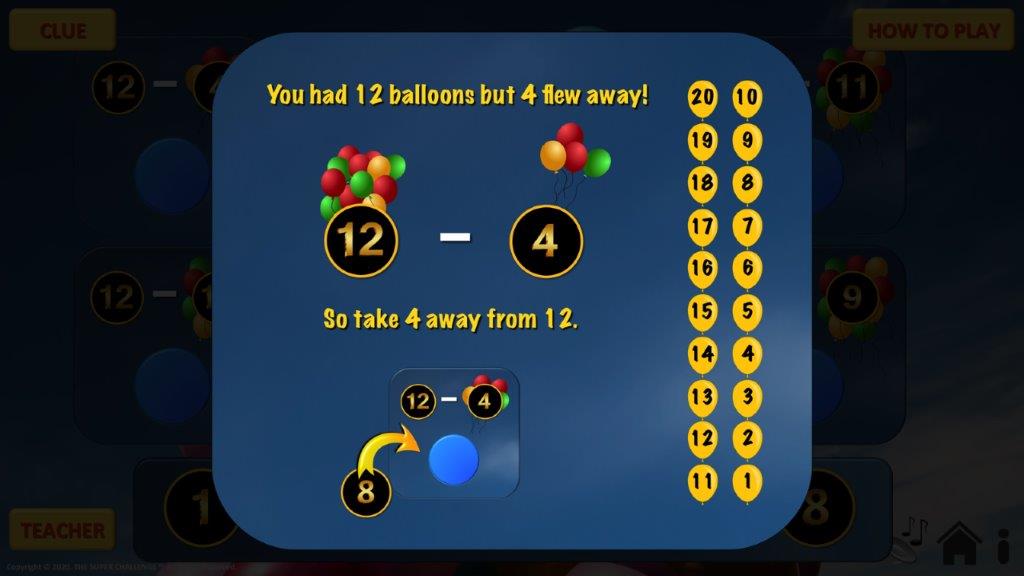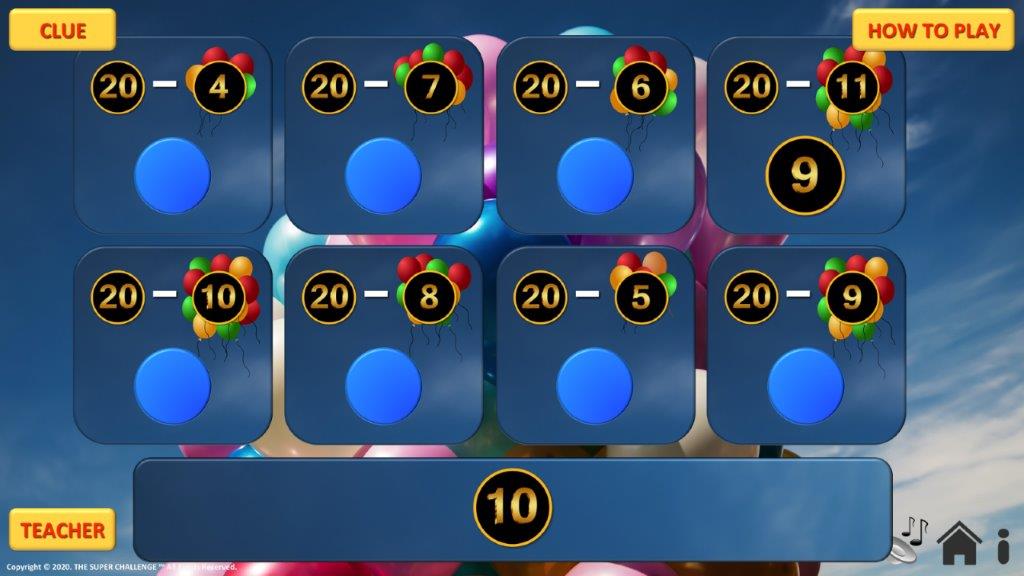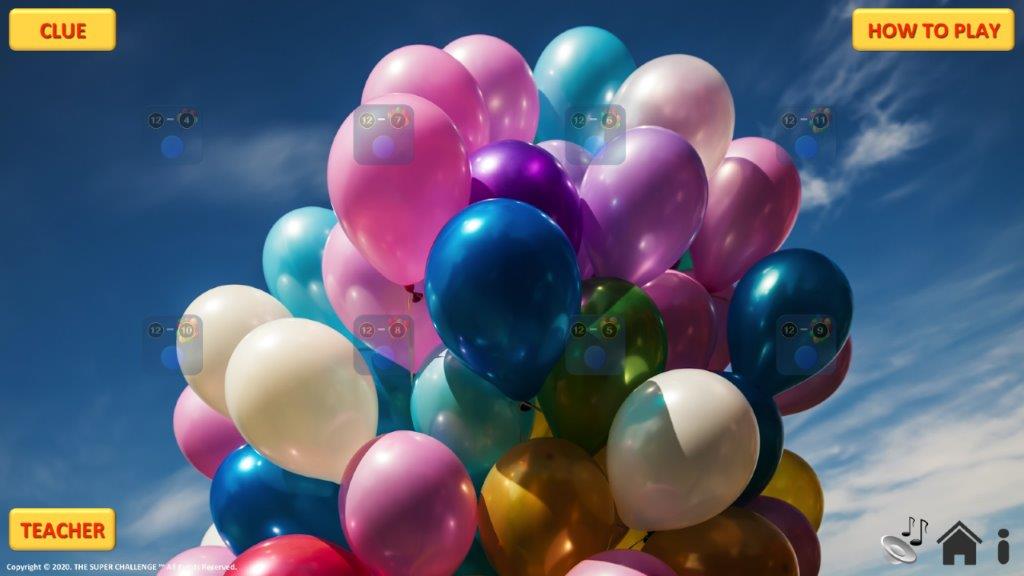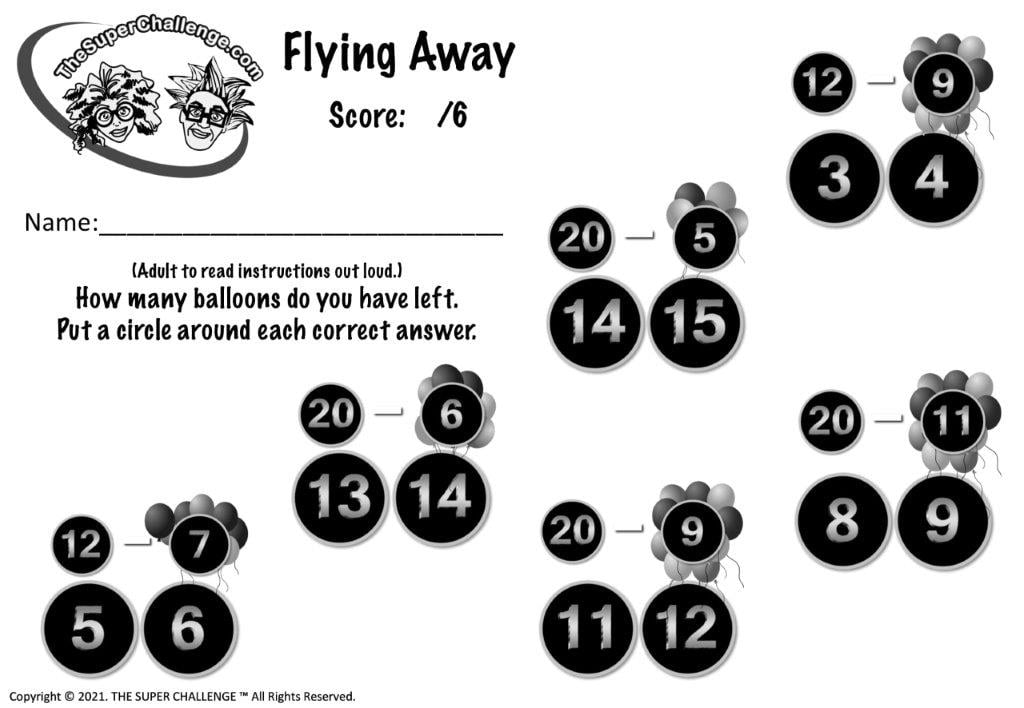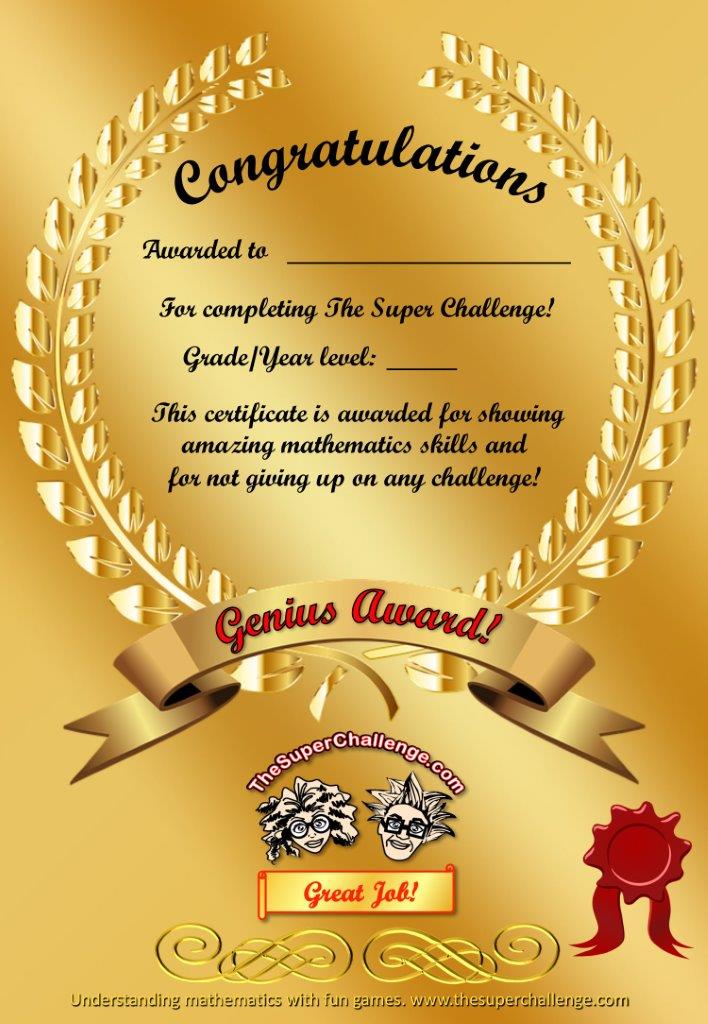YOUR SUPER CHALLENGE:
(Adult to read aloud.) Your challenge is to complete any 5 games from YOUR grade level. You may do any combination of Mid-level or Advanced level games as long as they are of YOUR grade. A game is only completed when you finish all the questions in the game. You may try some games first to see which ones you would like to play. For games that have different versions, (Standard/Advanced, Money etc), you only need to complete one of the versions. If you do other versions of the same game, it is still counted as only one game.
If you shut the game down, you will have to play from the start again. But if you write down your answers on the worksheet as you play, you can catch up to where you left the game. (The worksheet is optional.)
Once you have fully finished 5 different games, you have completed your challenge and may download your Certificate of Congratulations! But don’t stop there, challenge YOURSELF to see how many more games you can complete!
PARENTS & TUTORS:
The “Advanced Level” games are set at a level students aim to be at by the END of their school year. Also, games are not designed to be played on Safari browsers and may not load. All games may be played on PC’s & laptops; however, some may also be played on tablets, see the listing under each game name.
Warning: Games are not designed to be played using the Safari browsers.
Games should only be played using a web browser such as Chrome, Firefox or Microsoft Edge.
Please open this website using one of these browsers.
It is also advised you have the latest version of the Chrome, Firefox or Microsoft Edge web browsers.
Grade 2 – Grade 3 Explained

PALM TREES
GAME PLAYS ON: PC & LAPTOP ONLY
Palm Trees - Game Description
Ages: 7 – 8 years old
Suits: Grade 2 students in Australia, Second Grade students in the U.S.A. & Canada and Year 3 students in England.
Solve simple addition problems, with 10 facts & adding 10.
This is an educational mathematics game helping students to understand addition using 10 facts. It is a very engaging and simple way for students of this age to learn this concept. Students must put 4 palm trees together in order from tallest to shortest. It is a fun and practical way for them to learn addition. The game challenging and keeps students engaged as there are many possible solutions to the problem.
It includes lots of pirate and beach sounds and is full of rewarding voice-overs to build student confidence when learning mathematics. It is designed to suit the Mathematics Curriculums of Australia, Canada, England and the U.S.A.
Teacher References:
(ACMMG037): Compare and order several shapes and objects based on length (in this case, height).
(ACMNA030): Solve simple addition problems. Becoming fluent with a range of mental strategies for addition and subtraction problems, such as commutativity for addition, building to 10, doubles, 10 facts and adding 10.
Ref: Australian Curriculum Mathematics.
How To Play:
A pirate has sent his mate to find shade on an island. Can you make four palm trees for them? You must make them TALLEST to SHORTEST. The tallest must be on the left-hand side. A palm tree cannot be the same HEIGHT as another! How tall is each palm tree? Now can you do it with the numbers in words? Are you ready for the challenge?
Palm Trees - Learning Outcomes
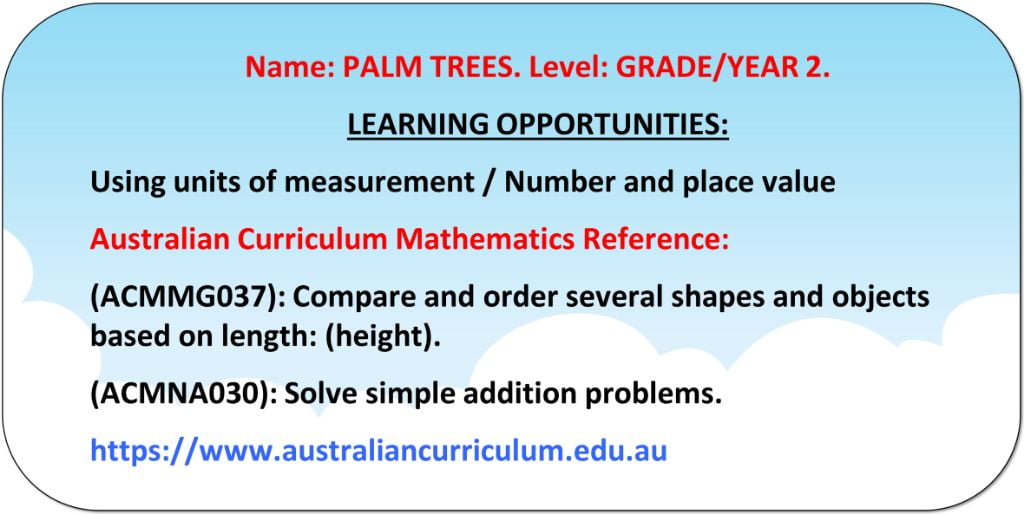
Palm Trees - Worksheet
TADPOLES – STANDARD
GAME PLAYS ON: PC & LAPTOP ONLY
Tadpoles Standard - Game Description
Ages: 7 – 8 years old
Suits: Grade 2 students in Australia, Second Grade students in the U.S.A. & Canada and Year 3 students in England.
Introducing simple addition and subtraction.
This game introduces addition and subtraction to students. It teaches that addition of two numbers can be done in any order (commutative) and subtraction of one number from another cannot.
The game is lots of fun and is set around a pond of tadpoles. With sounds of nature it is a very calming way for students to learn. The game is also full of encouraging words to build mathematical confidence. It is designed to suit the Mathematics Curriculums of Australia, Canada, England and the U.S.A.
Teacher References:
(ACMNA029): Explore the connection between addition and subtraction.
(ACMNA030): Solve simple addition and subtraction problems using a range of efficient mental and written strategies.
Ref: Australian Curriculum Mathematics.
How To Play:
For a school project, you have to count how many tadpoles you can see in a pond. Some tadpoles swim away, so to make sure you don’t count them twice, you count them in groups. Can you find the total number of tadpoles for your project?
Tadpoles Standard - Learning Outcomes
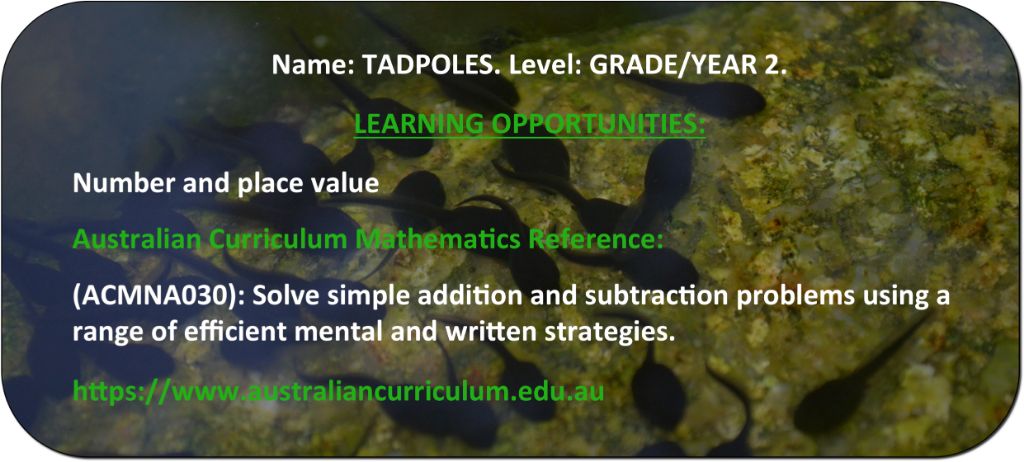
Tadpoles - Standard - Worksheet
TADPOLES – ADVANCED
GAME PLAYS ON: PC & LAPTOP ONLY
Tadpoles Advanced - Game Description
Ages: 7 – 8 years old
Suits: Grade 2 students in Australia, Second Grade students in the U.S.A. & Canada and Year 3 students in England.
Introducing more difficult addition and subtraction problems for this age group.
This game includes advanced sums for students. Again, it teaches that addition of two numbers can be done in any order (commutative) and subtraction of one number from another cannot.
The advanced version is also lots of fun to play and once again is set around a pond of tadpoles. The game is also full of encouraging words to build mathematical confidence. It is designed to suit the Mathematics Curriculums of Australia, Canada, England and the U.S.A.
Teacher References:
(ACMNA029): Explore the connection between addition and subtraction.
(ACMNA030): Solve simple addition and subtraction problems using a range of efficient mental and written strategies.
Ref: Australian Curriculum Mathematics.
How To Play:
You did very well on your school project counting tadpoles. You have returned to the pond. Now there are more tadpoles. Can you count them for your next school project? This time it’s tricky as there are many more tadpoles. But you can do it!
Tadpoles - Advanced - Learning Outcomes
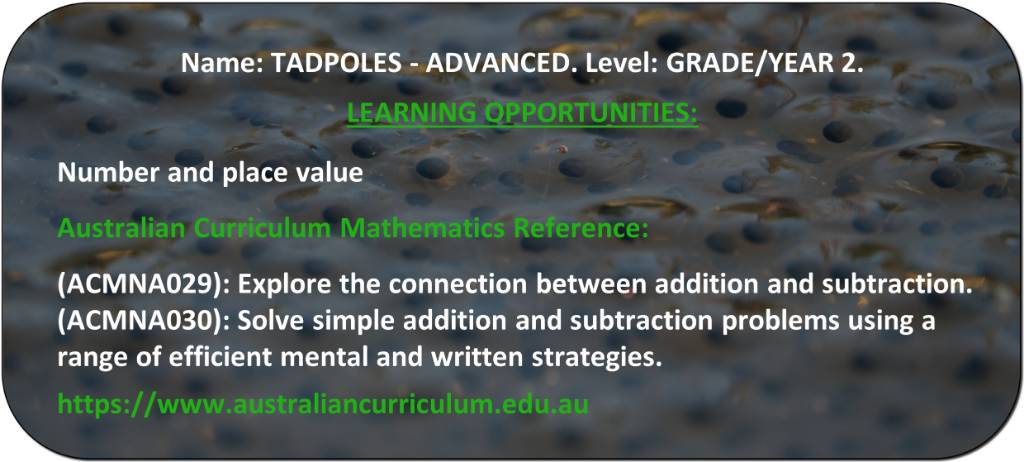
Tadpoles - Advanced - Worksheet
TELL THE TIME – STANDARD
GAME PLAYS ON: PC & LAPTOP ONLY
Tell the Time Standard - Game Description
Ages: 7 – 8 years old
Suits: Grade 2 students in Australia, Second Grade students in the U.S.A. & Canada and Year 3 students in England.
Learning to read the time on analogue clocks.
This is an educational mathematics game introducing how to read the time and is the easiest of the time-series games for this age group. It teaches students how to tell time to the quarter-hour on analogue clocks. The game focuses on language used to tell the time, such as ‘past’ and ‘to’.
It is set around a ride on a steam train with old steam train sound effects. Fun to play and full of encouraging words to build mathematical confidence, it is designed to suit the Mathematics Curriculums of Australia, Canada, England and the U.S.A.
Teacher References:
(ACMMG039): Tell time to the quarter-hour, using the language of ‘past’ and ‘to’. (Focusing on ANALOGUE clocks, for DIGITAL clocks see the game SPEED TRAIN.)
Ref: Australian Curriculum Mathematics.
How To Play:
You are going to the cinema to watch a movie. What time does the movie start? Can you read the time? Click on one of the clocks. Only 1 of the 4 answers you are given is correct. Which one is it?
You don’t want to be late for the movie!
Tell the Time – Standard - Learning Outcomes
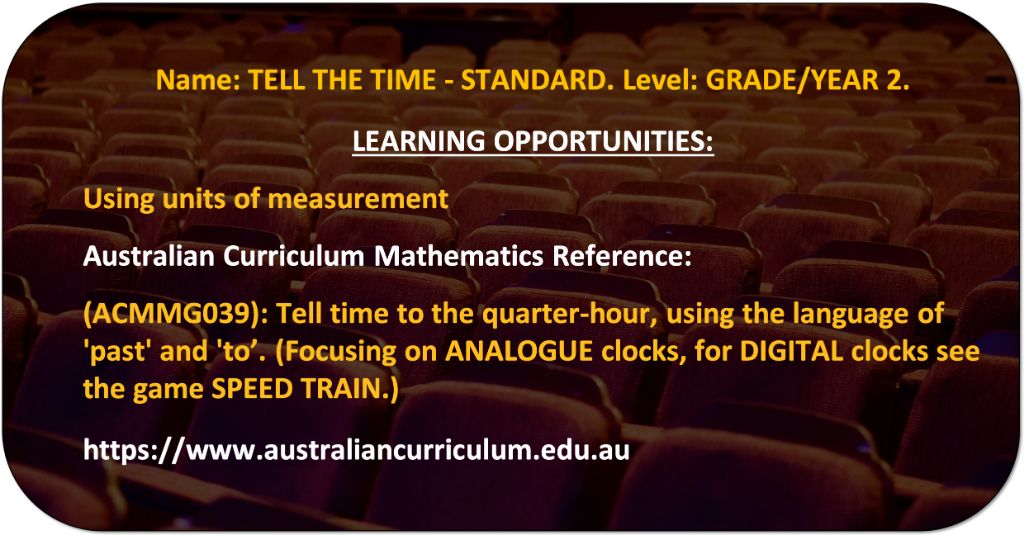
Tell the Time - Standard - Worksheet
TELL THE TIME – ADVANCED
GAME PLAYS ON: PC & LAPTOP ONLY
Tell the Time Advanced - Game Description
Ages: 7 – 8 years old
Suits: Grade 2 students in Australia, Second Grade students in the U.S.A. & Canada and Year 3 students in England.
Learning to read the time on analogue clocks that do not have numbers.
This game introduces how to read the time and is the more difficult of the “Tell The Time” games for this age group. Students must be able to read the time on clocks that have no numbers. It teaches students how to tell time to the quarter-hour on analogue clocks. The game focuses on language used to tell the time, such as ‘past’ and ‘to’.
It is set around a ride on a steam train with old steam train sound effects. Fun to play and full of encouraging words to build mathematical confidence, it is designed to suit the Mathematics Curriculums of Australia, Canada, England and the U.S.A.
Teacher References:
(ACMMG039): Tell time to the quarter-hour, using the language of ‘past’ and ‘to’. (Focusing on ANALOGUE clocks, for DIGITAL clocks see the game SPEED TRAIN.)
Ref: Australian Curriculum Mathematics.
How To Play:
You are going for a ride on an old steam train. What time does your train leave? The clocks don’t have any numbers on them. It’s a real challenge, but you can do it! Do you know what “a quarter-to” means? Where does the large hand point when it is “a quarter-to”?
Tell the Time – Advanced - Learning Outcomes

Tell the Time - Advanced - Worksheet
UNDERWATER
GAME PLAYS ON: PC & LAPTOP ONLY
Underwater - Game Description
Ages: 7 – 8 years old
Suits: Grade 2 students in Australia, Second Grade students in the U.S.A. & Canada and Year 3 students in England.
Learning half and quarter turns in preparation for reading the time.
This is an educational mathematics game teaching half and quarter turns. It introduces the characteristics of quarter-past and half-past times on an analogue clock. It also teaches students the concepts of “clockwise” and “anticlockwise”.
The game is set underwater with lots of dolphin and bubble sounds. Fun to play and full of encouraging words to build mathematical confidence, it is designed to suit the Mathematics Curriculums of Australia, Canada, England and the U.S.A.
Teacher References:
(ACMMG046): Identify and describe half and quarter turns.
Ref: Australian Curriculum Mathematics.
How To Play:
You are a scuba diver. You are underwater just off the shore of a tropical island. As you turn around you see different types of fish.
What can you see when you do a quarter turn clockwise?
Think of a clock, it turns clockwise. What can you see? Be careful as you must get the answer correct on your first or second try, or the GAME STARTS AGAIN! Are you ready for the challenge?
Underwater - Learning Outcomes

Underwater - Worksheet
BALLOONS
GAME PLAYS ON: PC & LAPTOP ONLY
Balloons - Game Description
Ages: 7 – 8 years old
Suits: Grade 2 students in Australia, Second Grade students in the U.S.A. & Canada and Year 3 students in England.
This is an educational mathematics game helping students learn partitioning of numbers and the importance of grouping in tens. It also teaches students, two-digit numbers as comprised of tens and ones. It is a challenging game for this level, but most students will complete it with perseverance.
The game is set around a hot-air balloon ride. It is lots of fun as it includes many encouraging words to build student confidence. It is designed to suit the Mathematics Curriculums of Australia, Canada, England and the U.S.A.
Teacher References:
(ACMNA028): Group, partition and rearrange collections up to 1000 in hundreds, tens, and ones to facilitate more efficient counting. (This game includes numbers to 100 as an introduction to partitioning. For numbers to 1000, see the game Lanterns.)
Ref: Australian Curriculum Mathematics.
How To Play:
You are going on a hot-air balloon ride. As you are on the ride you can see lots of other balloons, so you count them. You have counted them in groups, can you add up the groups to get the total? Let’s find out! It can be tricky. Are you ready for the challenge?
Balloons - Learning Outcomes

Balloons - Worksheet
SPEED TRAIN
GAME PLAYS ON: PC & LAPTOP ONLY
Speed Train - Game Description
Ages: 7 – 8 years old
Suits: Grade 2 students in Australia, Second Grade students in the U.S.A. & Canada and Year 3 students in England.
This game teaches students to tell time to the quarter-hour on digital clocks.
This is an educational mathematics game helping students learn to tell the time on digital clocks. The game focuses on the language used to tell the time, such as ‘past’ and ‘to’.
It is set around a ride on a speed train and includes lots of train sound effects. Fun to play and full of encouraging words to build mathematical confidence, it is designed to suit the Mathematics Curriculums of Australia, Canada, England and the U.S.A.
Teacher References:
(ACMMG039): Tell time to the quarter-hour, using the language of ‘past’ and ‘to’. (Focusing on digital clocks, for analogue clocks see the game TELL THE TIME.)
Ref: Australian Curriculum Mathematics.
How To Play:
You are going for a ride on a speed train. This train is very fast, perhaps the fastest in the world! You had better know how to read the time or you may miss your train. Blink and the train will be gone! Do you know what “a quarter-past” means?
Speed Train - Learning Outcomes
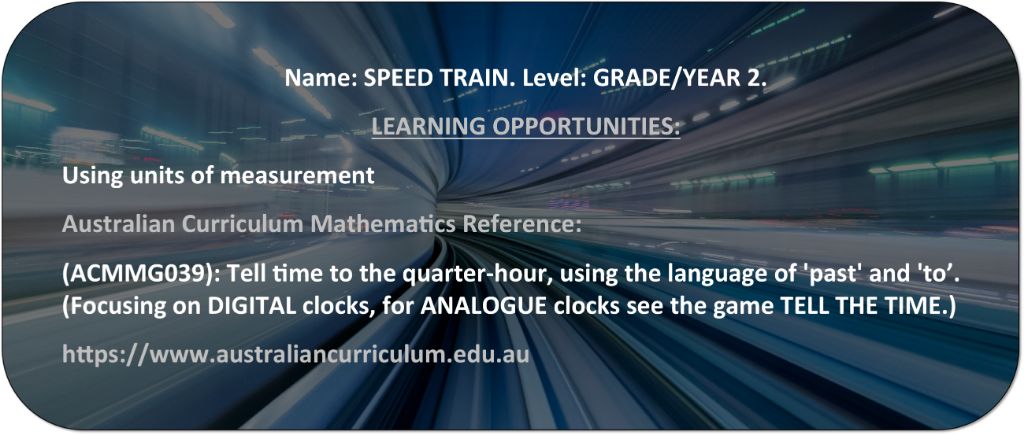
Speed Train - Worksheet
RESCUE
GAME PLAYS ON: PC, LAPTOP & TABLET
Rescue - Game Description
Ages: 7 – 8 years old
Suits: Grade 2 students in Australia, Second Grade students in the U.S.A. & Canada and Year 3 students in England.
Introducing addition and subtraction problems to students.
This game explores the connection between addition and subtraction. It is a very engaging and simple way for students of this age to learn how to solve number sentence problems. Students use counting-on to identify the missing element in an additive problem. This game makes it easy to understand as it presents number sentences it in a very clear and practical way without the need for the “+” and “-” symbols.
Set in outer space, students must solve number sentences to open a hatch door and rescue an astronaut. It is lots of fun and very engaging. This game is designed to suit the Mathematics Curriculums of Australia, Canada, England and the U.S.A.
Teacher References:
(ACMNA030): Solve simple addition and subtraction problems using a range of efficient mental and written strategies.
Ref: Australian Curriculum Mathematics.
How To Play:
You are a pilot and need to rescue an astronaut. You are the only one who can open the spacecraft door. Complete the challenge to open the door! The number 5 will appear in the middle circle. Then drag numbers onto the blue circles. You must make every arrow add up to 15. Then your challenge is next! The number 4 will appear in the middle circle. To open the door every arrow must add up to 12. Can you do it? Your astronaut is depending on you!
Rescue - Learning Outcomes
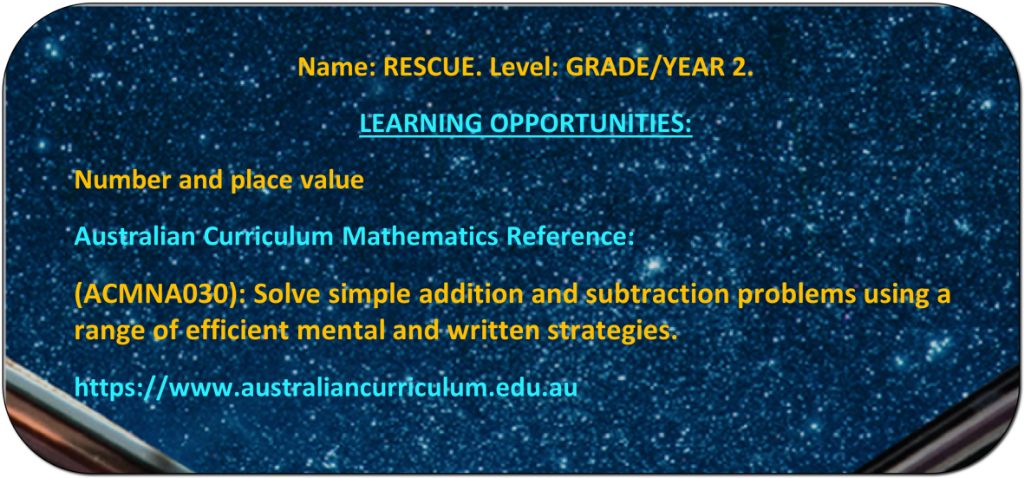
Rescue - Worksheet
SHOPPING – AUSTRALIA
GAME PLAYS ON: PC & LAPTOP ONLY
Shopping - Australia - Game Description
Ages: 7 – 8 years old
Suits: Grade 2 students in Australia.
Helping students to make purchases using Australian coins and notes.
This is an educational mathematics game helping students identify values of Australian coins and notes. It introduces students to making purchases. It teaches students to identify equivalent values in collections of coins or notes, such as two five-cent coins having the same value as one ten-cent coin.
It is loads of fun and filled with comical voice overs and sounds. Full of positive and encouraging words to build mathematical confidence and designed to suit the Mathematics Curriculum of Australia.
Teacher References:
(ACMNA034): Count and order small collections of coins and notes according to their value. Counting collections of coins or notes to make up a particular value, such as that shown on a price tag. Identifying equivalent values in collections of coins or notes, such as two five-cent coins having the same value as one ten-cent coin.
Ref: Australian Curriculum Mathematics.
How To Play:
It’s your dog’s birthday! You are taking her and a friend on a shopping spree. You buy them lots of gifts. Click on one of the things you buy. Choose the correct amount of money to pay for it. Take your time to work it out. If you give the wrong amount twice, the game starts again! Are you ready for the challenge?
Shopping – Australia - Learning Outcomes
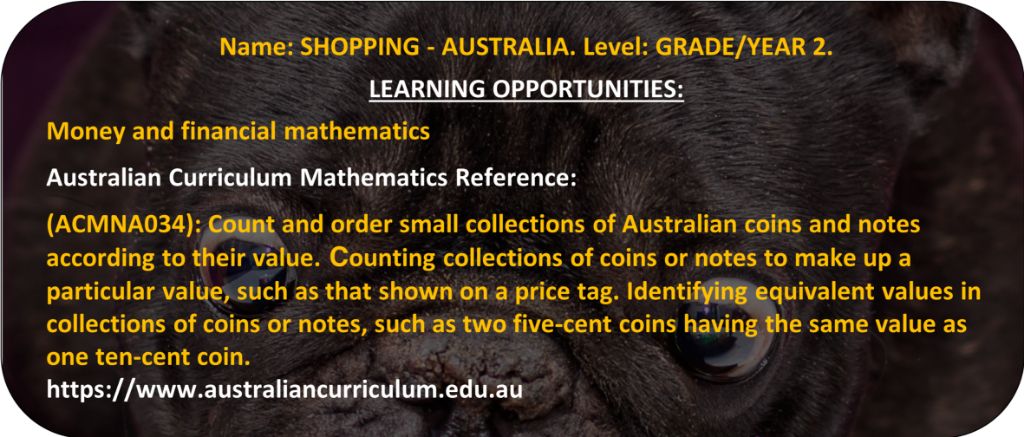
Shopping - Australia - Worksheet
SHOPPING – CANADA
GAME PLAYS ON: PC & LAPTOP ONLY
Shopping - Canada - Game Description
Ages: 7 – 8 years old
Suits: Second Grade students in Canada.
Helping students to make purchases using Canadian coins and notes.
This is an educational mathematics game helping students identify values of Canadian coins and notes. It introduces students to making purchases. It teaches students to identify equivalent values in collections of coins or notes, such as two five-cent coins having the same value as one ten-cent coin.
It is loads of fun and filled with comical voice overs and sounds. The game is full of positive and encouraging words to build mathematical confidence. It is designed to suit the Mathematics Curriculum of Canada.
Teacher References:
(ACMNA034): Count and order small collections of coins and notes according to their value. Counting collections of coins or notes to make up a particular value, such as that shown on a price tag. Identifying equivalent values in collections of coins or notes, such as two five-cent coins having the same value as one ten-cent coin.
Ref: Australian Curriculum Mathematics.
How To Play:
It’s your dog’s birthday! You are taking her and a friend on a shopping spree. You buy them lots of gifts. Click on one of the things you buy.
Choose the correct amount of money to pay for it. Take your time to work it out. If you give the wrong amount twice, the game starts again! Are you ready for the challenge?
Shopping – Canada - Learning Outcomes
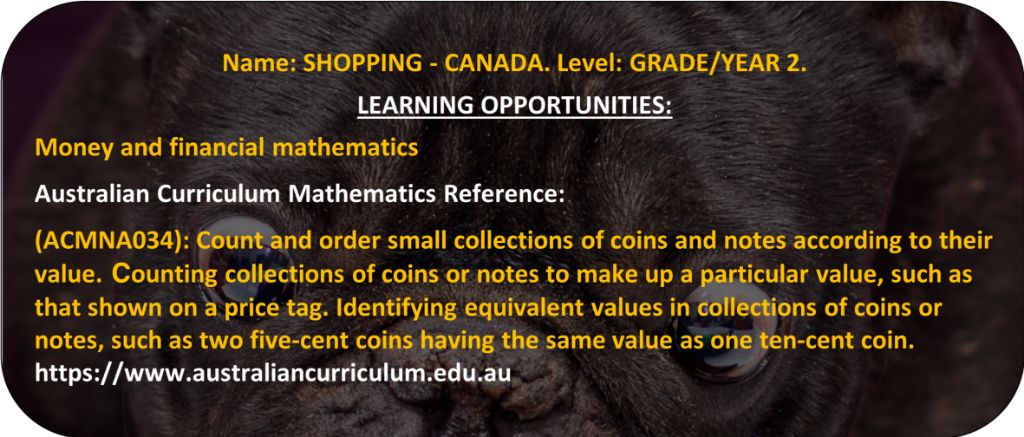
Shopping - Canada - Worksheet
SHOPPING – ENGLAND
GAME PLAYS ON: PC & LAPTOP ONLY
Shopping – England - Game Description
Ages: 7 – 8 years old
Suits: Year 3 students in England.
Helping students to make purchases using British coins and notes.
This is an educational mathematics game helping students identify values of British coins and notes. It also introduces students to making purchases. It teaches students to identify equivalent values in collections of coins or notes, such as two five-pence coins having the same value as one ten-pence coin.
It is loads of fun and filled with comical voice overs and sounds. The game is full of positive and encouraging words to build mathematical confidence. It is designed to suit the Mathematics Curriculum of England.
Teacher References:
(ACMNA034): Count and order small collections of coins and notes according to their value. Counting collections of coins or notes to make up a particular value, such as that shown on a price tag. Identifying equivalent values in collections of coins or notes, such as two five-pence coins having the same value as one ten-pence coin.
Ref: Australian Curriculum Mathematics.
How To Play:
It’s your dog’s birthday! You are taking her and a friend on a shopping spree. You buy them lots of gifts. Click on one of the things you buy. Choose the correct amount of money to pay for it. Take your time to work it out. If you give the wrong amount twice, the game starts again! Are you ready for the challenge?
Shopping – England - Learning Outcomes
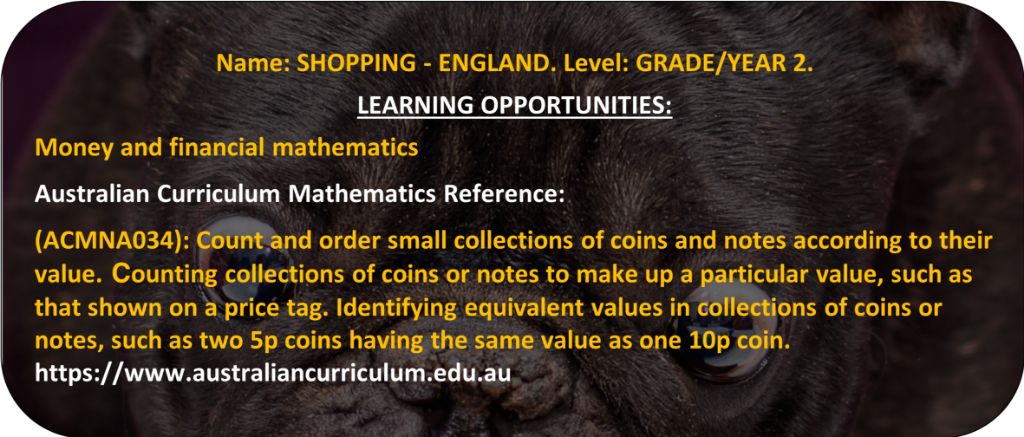
Shopping - England - Worksheet
SHOPPING – USA
GAME PLAYS ON: PC & LAPTOP ONLY
Shopping - USA - Game Description
Ages: 7 – 8 years old
Suits: Second Grade students in the U.S.A.
Teaching students how to make purchases using U.S.A. coins and notes.
This is an educational mathematics game helping students identify values of USA coins and notes. It introduces students to making purchases. It teaches students to identify equivalent values in collections of coins or notes, such as two five-cent coins having the same value as one ten-cent coin.
It is loads of fun and filled with comical voice overs and sounds. The game is full of positive and encouraging words to build mathematical confidence. It is designed to suit the Mathematics Curriculum of the U.S.A.
Teacher References:
(ACMNA034): Count and order small collections of coins and notes according to their value. Counting collections of coins or notes to make up a particular value, such as that shown on a price tag. Identifying equivalent values in collections of coins or notes, such as two five-cent coins having the same value as one ten-cent coin.
Ref: Australian Curriculum Mathematics.
How To Play:
It’s your dog’s birthday! You are taking her and a friend on a shopping spree. You buy them lots of gifts. Click on one of the things you buy. Choose the correct amount of money to pay for it. Take your time to work it out. If you give the wrong amount twice, the game starts again! Are you ready for the challenge?
Shopping – USA - Learning Outcomes
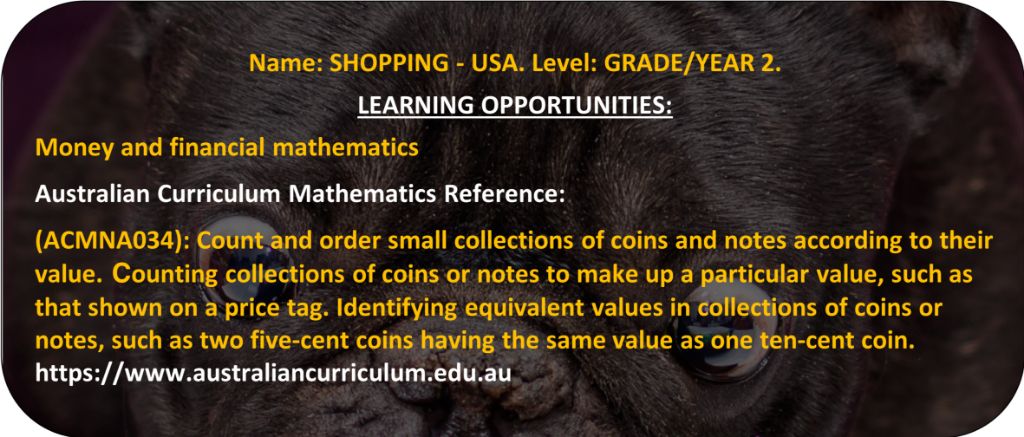
Shopping - USA - Worksheet
TIME MACHINE
GAME PLAYS ON: PC & LAPTOP ONLY
Time Machine - Game Description
Ages: 7 – 8 years old
Suits: Grade 2 students in Australia, Second Grade students in the U.S.A. & Canada and Year 3 students in England.
Identifying and describing geometric features of two- & three-dimensional shapes and objects.
This game explores features of two-dimensional shapes and three-dimensional objects. Students learn to identify key features of shapes such as straight lines or curved lines, and counting the corners, edges and faces.
Set in ancient Egypt with fascinating sound effects it is an exciting and very engaging way for students to learn about shapes. This game is designed to suit the Mathematics Curriculums of Australia, Canada, England and the U.S.A.
Teacher References:
(ACMMG042): Describe and draw two-dimensional shapes. Identifying key features of squares, rectangles, triangles, kites, rhombuses and circles, such as straight lines or curved lines, and counting the edges and corners.
(ACMMG043): Describe the features of three-dimensional objects. Identifying geometric features such as the number of faces, corners or edges.
Ref: Australian Curriculum Mathematics.
How To Play:
You have traveled in a time machine to ancient Egypt. The king knows you are from the future and has asked you to help build a pyramid, so you must know your shapes! Click on a shape. Only one of the 4 answers given is correct. Choose your answer, then drag it to the shape above. Your answer must be the TOTAL number for each shape. If you can complete the challenge, the king will let you travel back home.
Time Machine - Learning Outcomes
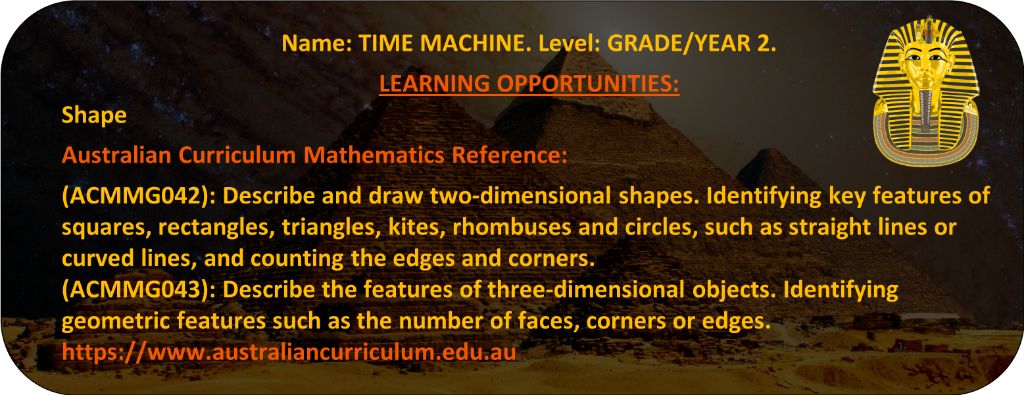
Time Machine - Worksheet
BUBBLE GUM
GAME PLAYS ON: PC, LAPTOP & TABLET
Bubble Gum - Game Description
Ages: 7 – 8 years old
Suits: Grade 2 students in Australia, Second Grade students in the U.S.A. & Canada and Year 3 students in England.
Understanding and describing outcomes in chance.
This is an educational mathematics game helping students understand “chance”. Students are asked to identify outcomes of events. They are asked to use everyday language such as ‘likely’ or ‘unlikely’ and identify some events as ‘certain’ or ‘impossible’.
Using bubble gum in jars as examples, it is very easy to understand and a very effective way for students to learn and describe chance outcomes. Fun to play and very engaging, it is designed to suit the Mathematics Curriculums of Australia, Canada, England and the U.S.A.
Teacher References:
(ACMSP047): Identify practical activities and everyday events that involve chance. Describe outcomes as ‘likely’ or ‘unlikely’ and identify some events as ‘certain’ or ‘impossible’. Classifying a list of everyday events according to how likely they are to happen, using the language of chance, and explaining reasoning.
Ref: Australian Curriculum Mathematics.
How To Play:
Do you like bubble gum? Here is a challenge for you! Can you pull out a red bubble gum? Close your eyes. Then put your hand into one of the jars and mix all the bubble gum up and pull one of them out. What is the chance of getting a red bubble gum? You will be given 4 answer choices, but only one is correct! Choose one of the answers. Drag your answer to the yellow circle to see if you are correct. You will be challenged!
Bubble Gum - Learning Outcomes
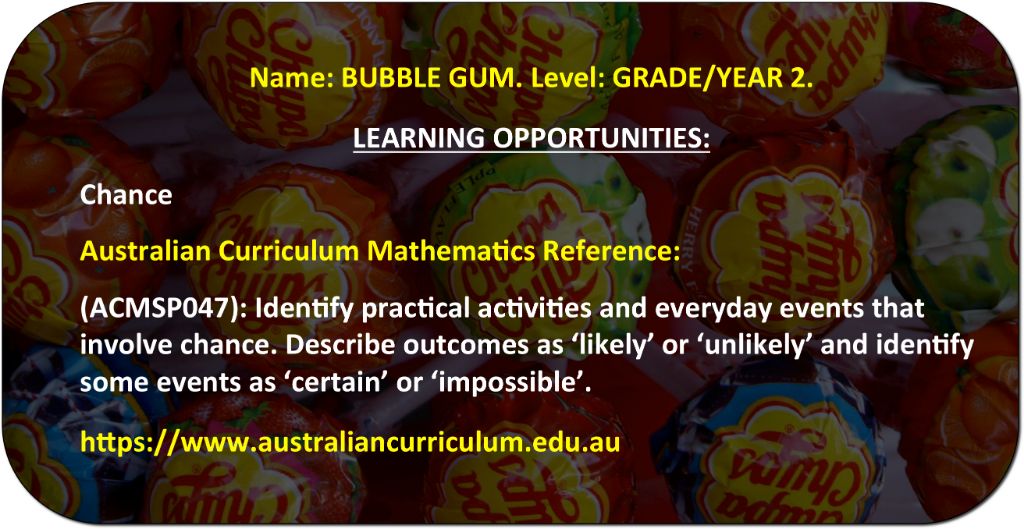
Bubblegum - Worksheet
GOLD STARS – STANDARD
GAME PLAYS ON: PC & LAPTOP ONLY
Gold Stars Standard - Game Description
Ages: 7 – 8 years old
Suits: Grade 2 students in Australia, Second Grade students in the U.S.A. & Canada and Year 3 students in England.
Learning simple multiplication.
This is the easier of the two “Gold Stars” games and teaches simple multiplication. It is a very engaging way for students of this age to learn what is for them, a challenging concept. This game makes it easy to understand as it presents multiplication it in a very clear and practical way.
It is lots of fun and filled with comical voice-overs and sounds and full of positive and encouraging words to build mathematical confidence. It is designed to suit the Mathematics Curriculums of Australia, Canada, England and the U.S.A.
Teacher References:
(ACMNA031): Represent multiplication as repeated addition, groups and arrays. Visualising / Visualizing a group of objects as a unit and using this to calculate the number of objects in several identical groups.
Ref: Australian Curriculum Mathematics.
How To Play:
Your teacher is giving out gold stars to the best students and you are one of them. Choose a page of stickers that you and your lucky students can share evenly. There must be no gold star stickers left over. Which sheet of stickers is the correct one? Take your time to work it out. If you get the answer wrong twice, the game starts again! Are you ready for the challenge?
Gold Stars – Standard - Learning Outcomes
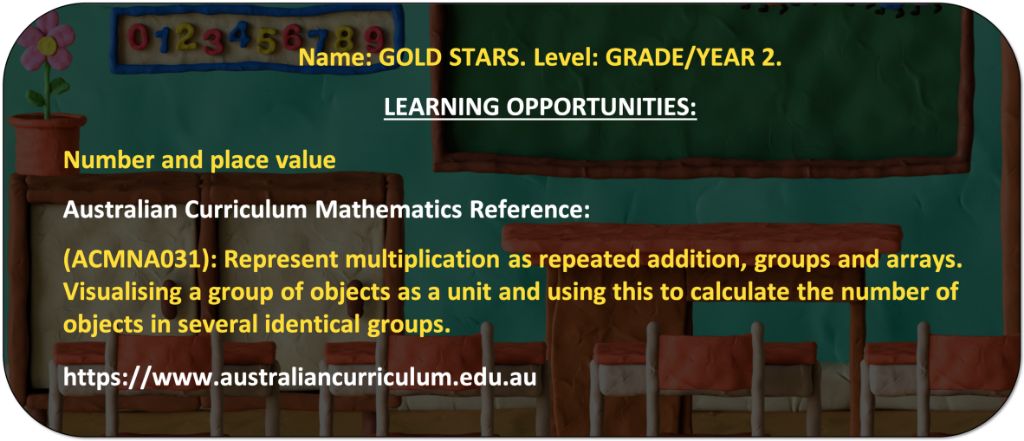
Gold Stars – Standard - Worksheet
GOLD STARS – ADVANCED
GAME PLAYS ON: PC & LAPTOP ONLY
Gold Stars Advanced - Game Description
Ages: 7 – 8 years old
Suits: Grade 2 students in Australia, Second Grade students in the U.S.A. & Canada and Year 3 students in England.
Learning how to multiply.
This is the more difficult of the two “Gold Stars’ games and introduces slightly more challenging sums. It is still within the reach of most students and should be played after the standard version of this game is completed. This game presents multiplication it in a very clear and practical way.
It is lots of fun and filled with comical voice-overs and sounds and full of positive and encouraging words to build mathematical confidence. It is designed to suit the Mathematics Curriculums of Australia, Canada, England and the U.S.A.
Teacher References:
(ACMNA031): Represent multiplication as repeated addition, groups and arrays. Visualising / Visualizing a group of objects as a unit and using this to calculate the number of objects in several identical groups.
Ref: Australian Curriculum Mathematics.
How To Play:
Your teacher is giving out gold stars to the best students and you are one of them. Choose a page of stickers that you and your lucky students can share evenly. There must be no gold star stickers left over. Which sheet of stickers is the correct one? Take your time to work it out. If you get the answer wrong twice, the game starts again! Are you ready for the challenge?
Gold Stars – Advanced - Learning Outcomes
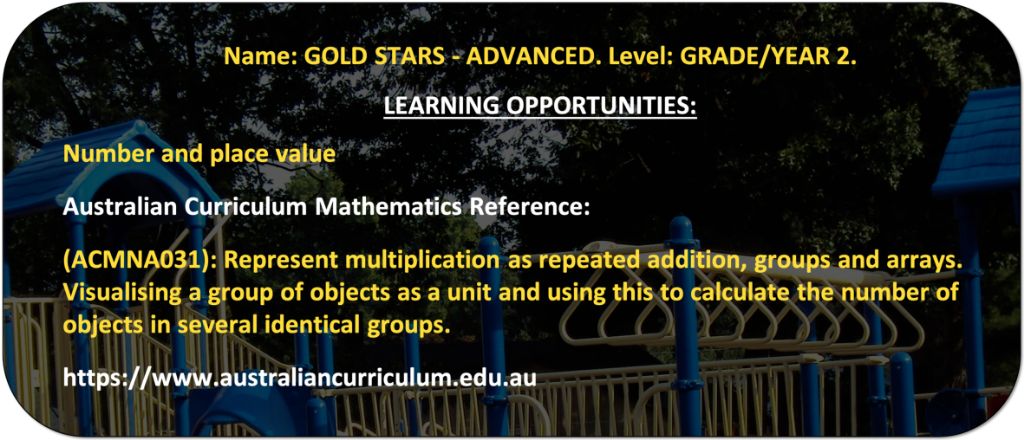
Gold Stars – Advanced - Worksheet
BUILDINGS
GAME PLAYS ON: PC & LAPTOP ONLY
Buildings - Game Description
Ages: 7 – 8 years old
Suits: Grade 2 students in Australia, Second Grade students in the U.S.A. & Canada and Year 3 students in England.
Introducing number patterns and sequences to students.
This game teaches students about number patterns. Students must make 5 buildings of different heights. They are then asked to investigate the number pattern and calculate the next biggest building. It’s challenging but lots of fun to play.
The game is full of encouraging words to build mathematical confidence and is designed to suit the Mathematics Curriculums of Australia, Canada, England and the U.S.A.
Teacher References:
(ACMNA026): Investigate number sequences, initially those increasing and decreasing by twos, threes and from any starting point.
(ACMNA035): Describe patterns with numbers and identify missing elements.
Ref: Australian Curriculum Mathematics.
How To Play:
You are a builder and you make 5 buildings. Can you make them in order from smallest to tallest? Notice the buildings are all different heights? Your challenge is to find the number pattern. How tall would the next biggest building be? A real challenge, but you can do it!
Buildings - Learning Outcomes
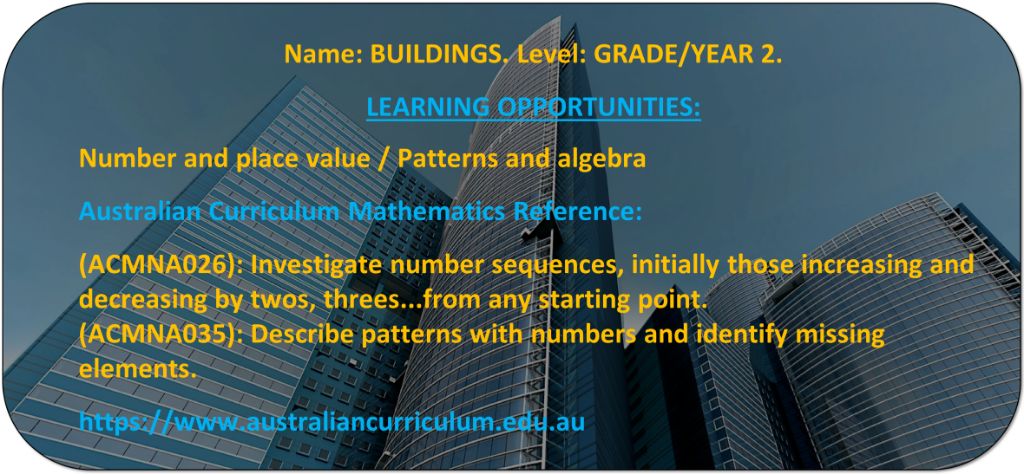
Buildings - Worksheet
MEERKATS – STANDARD
GAME PLAYS ON: PC & LAPTOP ONLY
Meerkats Standard - Game Description
Ages: 7 – 8 years old
Suits: Grade 2 students in Australia, Second Grade students in the U.S.A. & Canada and Year 3 students in England.
Solve simple addition problems.
This is an educational mathematics game helping students learn how to add, it does not include subtraction. The game involves mental strategies, such as commutativity for addition, building to 10, doubles, 10 facts and adding 10.
Set in Africa on a wildlife preserve with sounds of meerkats and cheetahs, it is very calming and fun to play. Full of encouraging words to build mathematical confidence, it is designed to suit the Mathematics Curriculums of Australia, Canada, England and the U.S.A.
Teacher References:
(ACMNA029): Explore the connection between addition and subtraction.
(ACMNA030): Solve simple addition and subtraction problems using a range of efficient mental and written strategies.
Ref: Australian Curriculum Mathematics.
How To Play:
Your job on a wildlife preserve is to count meerkats. You have counted them, but you have to add up numbers to get the total. You will be given 4 answers but only 1 answer is correct. Which one is it?
Meerkats – Standard - Learning Outcomes
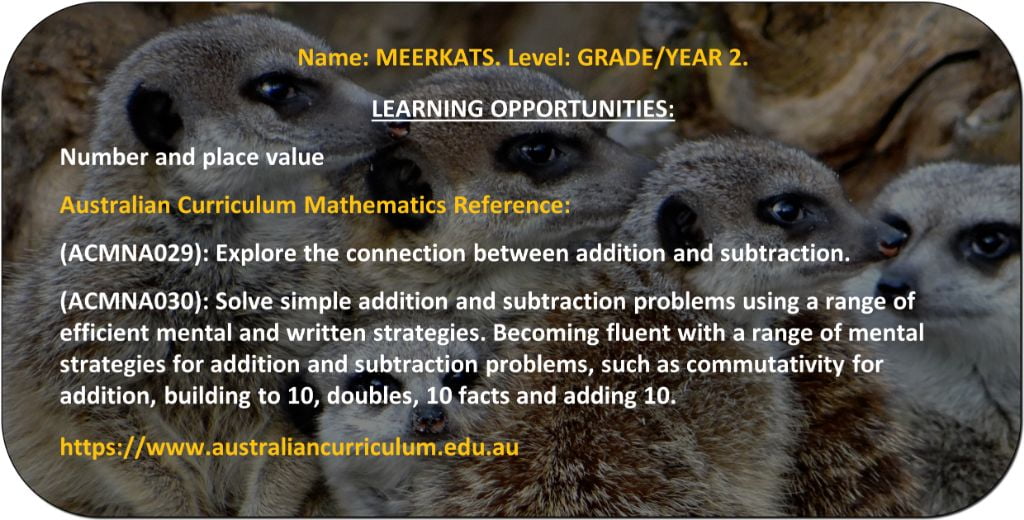
Meerkats – Standard - Worksheet
MEERKATS – ADVANCED
GAME PLAYS ON: PC & LAPTOP ONLY
Meerkats Advanced - Game Description
Ages: 7 – 8 years old
Suits: Grade 2 students in Australia, Second Grade students in the U.S.A. & Canada and Year 3 students in England.
Understanding the connection between addition & subtraction.
This is the more challenging version of the “Meerkats” games as it involves both addition and subtraction.
Set in Africa on a wildlife preserve with sounds of meerkats and cheetahs, it is very calming and fun to play. Full of encouraging words to build mathematical confidence, it is designed to suit the Mathematics Curriculums of Australia, Canada, England and the U.S.A.
Teacher References:
(ACMNA029): Explore the connection between addition and subtraction.
(ACMNA030): Solve simple addition and subtraction problems using a range of efficient mental and written strategies.
Ref: Australian Curriculum Mathematics.
How To Play:
You have a job on a wildlife preserve in Africa! Your job is to count the number of meerkats you can see. This time some meerkats keep hiding from cheetahs. You will have to add and subtract to get the totals. It’s a tricky task to get the total right, but you can do it!
Meerkats – Advanced - Learning Outcomes
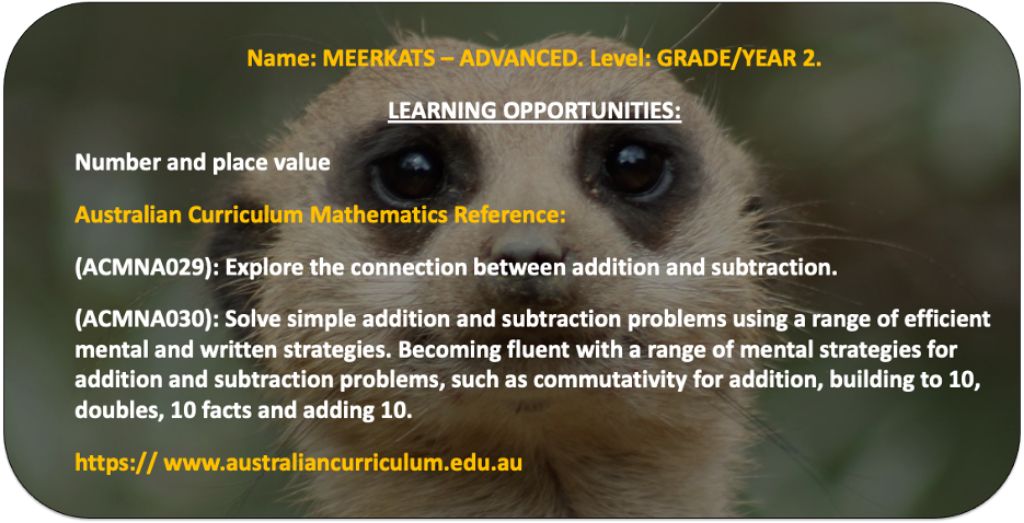
Meerkats – Advanced - Worksheet
COINS – AUSTRALIA
GAME PLAYS ON: PC, LAPTOP & TABLET
Coins - Australia - Game Description
Ages: 7 – 8 years old
Suits: Grade 2 students in Australia.
Teaching students how to identify and to add up Australian coins in preparation to make purchases.
This is an educational mathematics game helping students identify values of Australian coins. It also teaches students to identify equivalent values in collections of coins, such as two five-cent coins having the same value as one ten-cent coin.
This game is loads of fun and filled with comical voice overs and sounds. It is full of positive and encouraging words to build mathematical confidence and is designed to suit the Mathematics Curriculum of Australia.
Teacher References:
(ACMNA034): Count and order small collections of coins according to their value. Identifying equivalent values in collections of coins or notes, such as two five-cent coins having the same value as one 10-cent coin.
Ref: Australian Curriculum Mathematics.
How To Play:
To be able to buy things, it’s important to know how much coins are worth. Can you add up coins? Let’s find out! Put money around the globe from SMALLEST amounts to LARGEST amounts. Drag your answers onto the blue circles. Click the blue box to see if you are correct. Then a challenge will appear!
Coins – Australia - Learning Outcomes

Coins – Australia - Worksheet
COINS – CANADA
GAME PLAYS ON: PC, LAPTOP & TABLET
Coins - Canada - Game Description
Ages: 7 – 8 years old
Suits: Second Grade students in Canada.
Teaching students how to identify and to add up Canadian coins in preparation to make purchases.
This is an educational mathematics game helping students identify values of Canadian coins. It also teaches students to identify equivalent values in collections of coins, such as two five-cent coins having the same value as one ten-cent coin.
This game is loads of fun and filled with comical voice overs and sounds. It is full of positive and encouraging words to build mathematical confidence and is designed to suit the Mathematics Curriculum of Canada.
Teacher References:
(ACMNA034): Count and order small collections of coins according to their value. Identifying equivalent values in collections of coins or notes, such as two five-cent coins having the same value as one 10-cent coin.
Ref: Australian Curriculum Mathematics.
How To Play:
To be able to buy things, it’s important to know how much coins are worth. Can you add up coins? Let’s find out! Put money around the globe from SMALLEST amounts to LARGEST amounts. Drag your answers onto the blue circles. Click the blue box to see if you are correct. Then a challenge will appear!
Coins – Canada - Learning Outcomes
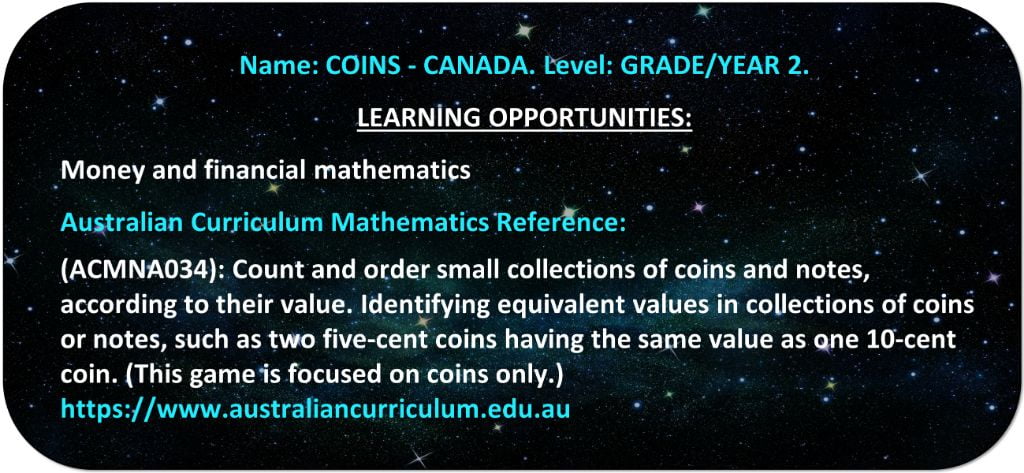
Coins – Canada - Worksheet
COINS – ENGLAND
GAME PLAYS ON: PC, LAPTOP & TABLET
Coins - England - Game Description
Ages: 7 – 8 years old
Suits: Year 3 students in England.
Teaching students how to identify and to add up British coins in preparation to make purchases.
This is an educational mathematics game helping students identify values of British coins. It also teaches students to identify equivalent values in collections of coins, such as two five-pence coins having the same value as one ten-pence coin.
This game is loads of fun and filled with comical voice overs and sounds. It is full of positive and encouraging words to build mathematical confidence and is designed to suit the Mathematics Curriculum of England.
Teacher References:
(ACMNA034): Count and order small collections of coins according to their value. Identifying equivalent values in collections of coins or notes, such as two five-pence coins having the same value as one 10-pence coin.
Ref: Australian Curriculum Mathematics.
How To Play:
To be able to buy things, it’s important to know how much coins are worth. Can you add up coins? Let’s find out! Put money around the globe from SMALLEST amounts to LARGEST amounts. Drag your answers onto the blue circles. Click the blue box to see if you are correct. Then a challenge will appear!
Coins – England - Learning Outcomes
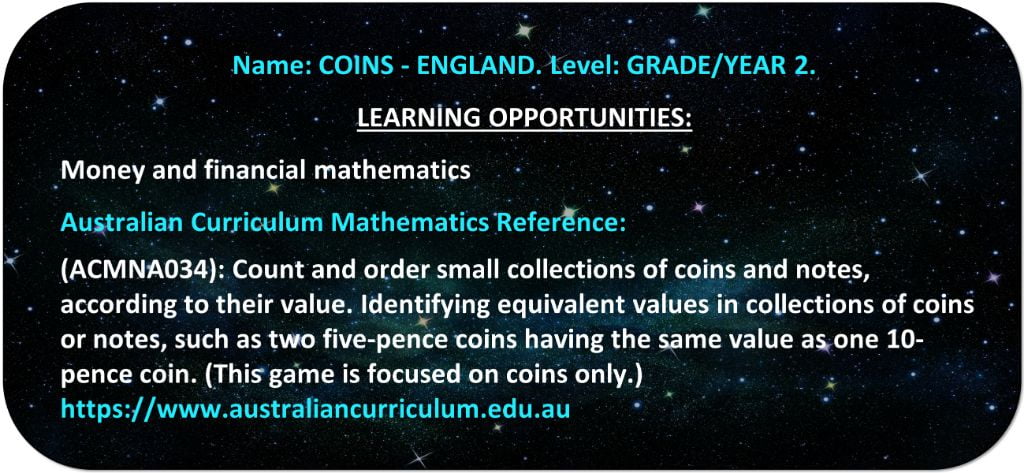
Coins – England - Worksheet
COINS – USA
GAME PLAYS ON: PC, LAPTOP & TABLET
Coins – U.S.A. - Game Description
Ages: 7 – 8 years old
Suits: Second Grade students in the U.S.A.
Teaching students how to identify and to add up U.S.A. coins in preparation to make purchases.
This is an educational mathematics game helping students identify values of U.S.A. coins. It also teaches students to identify equivalent values in collections of coins, such as two five-cent coins having the same value as one ten-cent coin.
This game is loads of fun and filled with comical voice overs and sounds. It is full of positive and encouraging words to build mathematical confidence and is designed to suit the Mathematics Curriculum of Australia.
Teacher References:
(ACMNA034): Count and order small collections of coins according to their value. Identifying equivalent values in collections of coins or notes, such as two five-cent coins having the same value as one 10-cent coin.
Ref: Australian Curriculum Mathematics.
How To Play:
To be able to buy things, it’s important to know how much coins are worth. Can you add up coins? Let’s find out! Put money around the globe from SMALLEST amounts to LARGEST amounts. Drag your answers onto the blue circles. Click the blue box to see if you are correct. Then a challenge will appear!
Coins – USA - Learning Outcomes
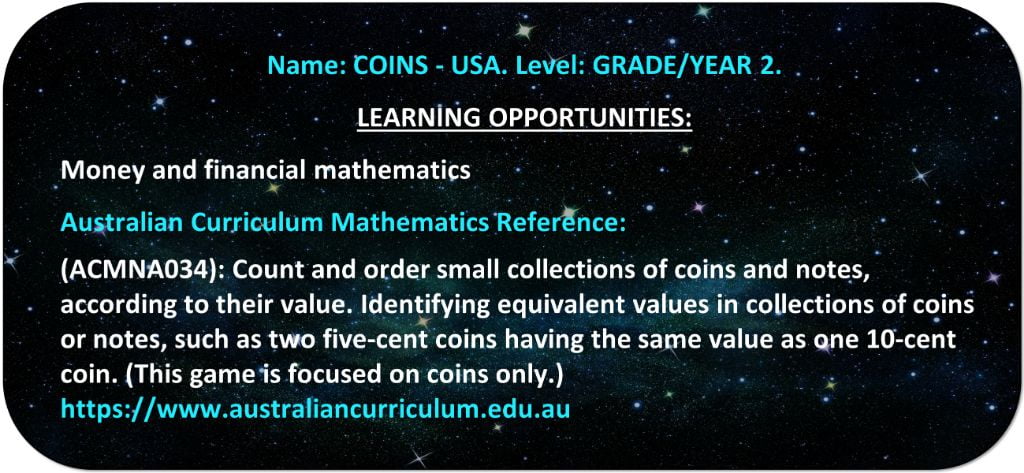
Coins – USA - Worksheet
SKATE PARK
GAME PLAYS ON: PC & LAPTOP ONLY
Skate Park - Game Description
Ages: 7 – 8 years old
Suits: Grade 2 students in Australia, Second Grade students in the U.S.A. & Canada and Year 3 students in England.
Learning to read the time on digital clocks.
This is an educational mathematics game introducing how to read the time on digital clocks and is slightly more challenging for this age group. Students must grasp that one hour has 60 minutes and therefore 15 minutes past is a quarter past etc. The game focuses on language used to tell the time, such as ‘past’ and ‘to’.
It is set at a skateboard park and is fun to play. It is full of encouraging words to build mathematical confidence and designed to suit the Mathematics Curriculums of Australia, Canada, England and the U.S.A.
Teacher References:
(ACMMG039): Tell time to the quarter-hour, using the language of ‘past’ and ‘to’. (Focusing on DIGITAL clocks, for ANALOGUE clocks see the game TELL THE TIME.)
Ref: Australian Curriculum Mathematics.
How To Play:
Every weekend you go to the skateboard park to watch the skaters. Your friends always meet you there. But every weekend you go at different times. You must learn to read the time so you can meet them. Choose one of the watches and click on it. Only 1 of the 4 answers matched the time given. Choose the correct answer and drag it to the watch above. Are you ready for this challenge? You can do it!
Skate Park - Learning Outcomes
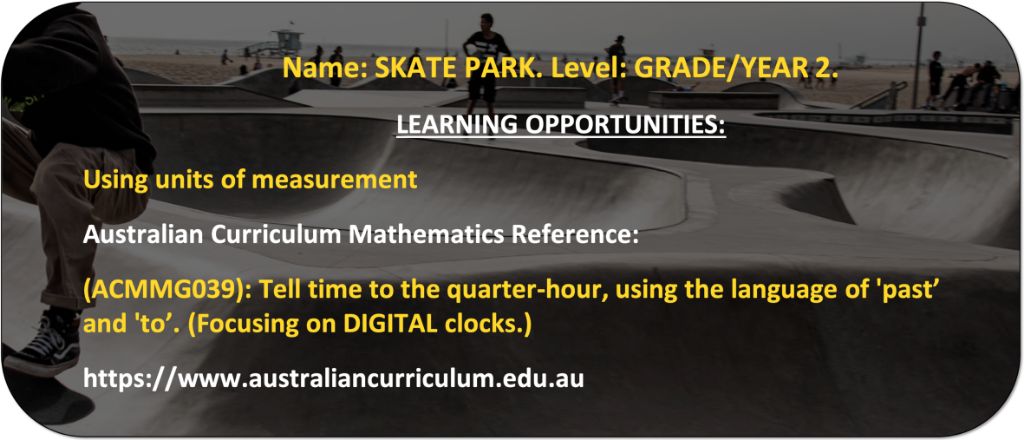
Skate Park - Worksheet
YOU’RE ON TV
GAME PLAYS ON: PC & LAPTOP ONLY
You’re on TV - Game Description
Ages: 7 – 8 years old
Suits: Grade 2 students in Australia, Second Grade students in the U.S.A. & Canada and Year 3 students in England.
Fractions explained in a simple and understandable way.
This is an educational mathematics game introducing fractions. It is a very simple and effective way to demonstrate a difficult topic for this age level. Students must identify how many candles are blown out on a birthday cake. They are then asked to compare the number blown out to the total number of candles. It is a very good way for students to understand the concept of fractions without using fraction symbols.
The game introduces various fractions but focuses on one-half and one-quarter, making it simple and easy to understand for this age level. It is designed to suit the Mathematics Curriculums of Australia, Canada, England and the U.S.A.
Teacher References:
(ACMNA033): Identify and interpret common uses of halves, quarters and eighths of shapes and collections. Relating the number of parts to the size of a fraction. (This game includes other fractional values.)
Ref: Australian Curriculum Mathematics.
How To Play:
You are a contestant on a TV game show. It is a contest to see who knows fractions! Each birthday cake has some candles blown out. How many are blown out? How many are there in total? (See the CLUE.) Click on a birthday cake. You are given 4 fractions but only one is correct. Choose the correct answer. Then drag your answer to the cake above. If you are correct the audience will applaud you. To win the contest you must complete the challenge!
You’re on TV - Learning Outcomes
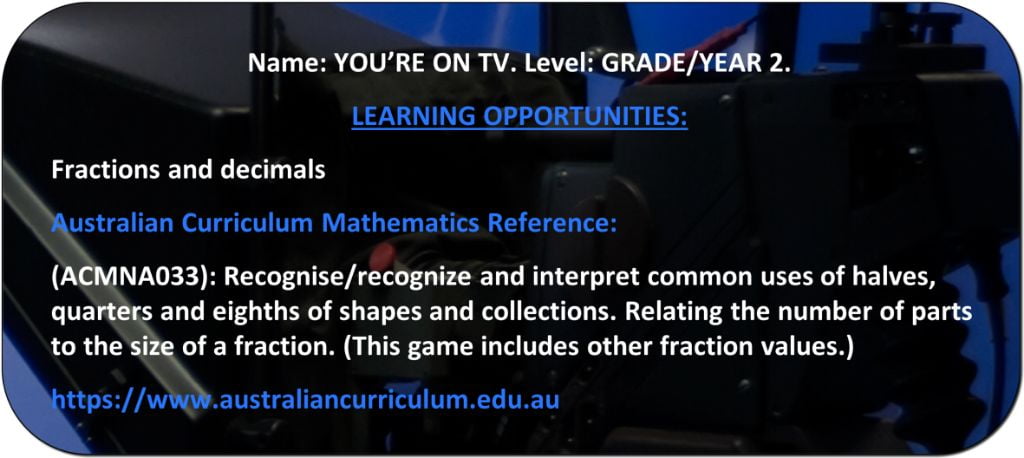
You’re on TV - Worksheet
LANTERNS
GAME PLAYS ON: PC & LAPTOP ONLY
Lanterns - Game Description
Ages: 7 – 8 years old
Suits: Grade 2 students in Australia, Second Grade students in the U.S.A. & Canada and Year 3 students in England.
Understanding three-digit numbers.
This game helps students learn about three-digit numbers. The game teaches students that three-digit numbers are comprised of hundreds, tens and ones.
Set in an old village under the stars and moonlight, it is an exciting game to play. Full of sounds of owls, wolves and wizards, it has a mystical atmosphere. It is also full of encouraging words to build mathematical confidence and is designed to suit the Mathematics Curriculums of Australia, Canada, England and the U.S.A.
Teacher Reference:
(ACMNA028): Group, partition and rearrange collections up to 1000, in hundreds, tens and ones to facilitate more efficient counting.
Ref: Australian Curriculum Mathematics.
How To Play:
The mayor of the village is counting lanterns. It is cold and beginning to snow. There is no electricity and only the moonlight for people to see by. Wolves are coming close to the village. Can you help her count how many lanterns the village has? She needs your help!
Lanterns - Learning Outcomes

Lanterns - Worksheet
THE WORLD 2
GAME PLAYS ON: PC, LAPTOP & TABLET
The World 2 - Game Description
Ages: 7 – 8 years old
Suits: Grade 2 students in Australia, Second Grade students in the U.S.A. & Canada and Year 3 students in England.
Learning how to count, skip-count and how to predict the next number in a number pattern.
This is an educational mathematics game helping students to develop confidence with number sequences and skip-counting by two’s, threes and fives. It also helps students to identify the next number in a number pattern. The game uses very practical examples to help students understand this concept. Students must put people of different cultures in order around the globe, according to their age.
Full of exciting sounds, it is a fun and engaging way for students to learn number sequences. It is designed to suit the Mathematics Curriculums of Australia, Canada, England and the U.S.A.
Teacher References:
(ACMNA026): Investigate number sequences, initially those increasing and decreasing by twos, threes, fives and tens from any starting point, then moving to other sequences.
Developing fluency and confidence with numbers and calculations by saying number sequences.
Ref: Australian Curriculum Mathematics.
How To Play:
The world is a wonderful place full of wonderful people. Some of them will appear of different ages. Can you put them in ORDER, from youngest to oldest? Then click the blue box to see if you are correct. Now for your challenge: Can you do it by 5’s and then by 3’s? Are you ready for the challenge?
The World 2 - Learning Outcomes
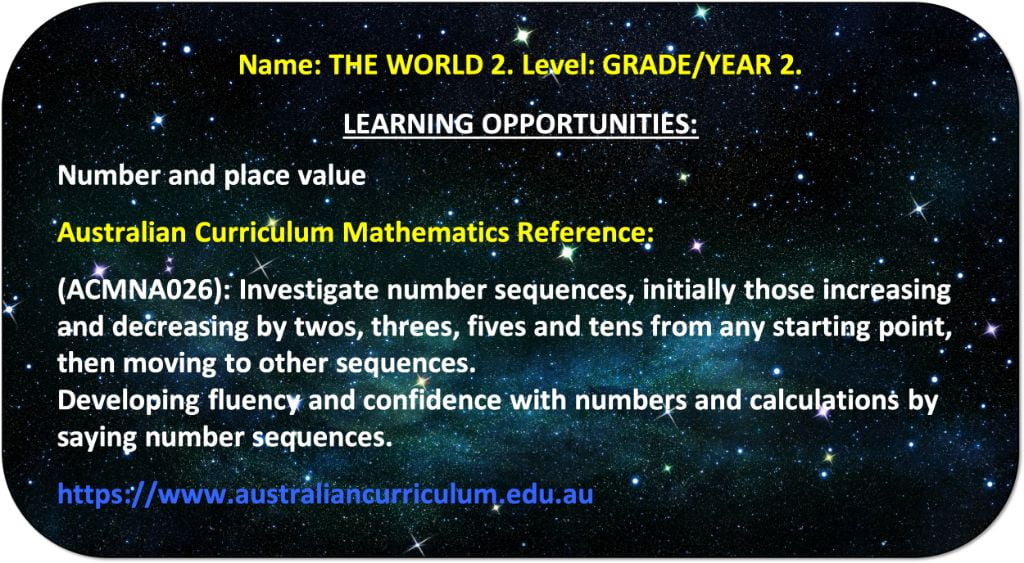
Birds and Cats - Worksheet
FLYING AWAY
GAME PLAYS ON: PC, LAPTOP & TABLET
Flying Away - Game Description
Ages: 7 – 8 years old
Suits: Grade 2 students in Australia, Second Grade students in the U.S.A. & Canada and Year 3 students in England.
Introducing subtraction problems using simple number sentences.
Students start with up to 20 balloons in a bunch. Some of the balloons escape and fly away. Students are then asked to calculate how many balloons remain. In this game examples of number sentences are used. It is a very practical way to introduce number sentences to this age group.
Full of exciting sounds, it is a fun and engaging way for students to learn subtraction. It is designed to suit the Mathematics Curriculums of Australia, Canada, England, and the U.S.A.
Teacher Reference:
(ACMNA030): Represent and solve simple addition and subtraction problems using a range of strategies. Developing a range of mental strategies for addition and subtraction problems.
Ref: Australian Curriculum Mathematics.
How To Play:
You have a bunch of 12 balloons. Some of them escape and fly away! Can you work out how many are left in your bunch? Drag your answer onto the blue circle. Once you have done them all, your challenge will appear. Now you have a bunch of 20 balloons and some escape again! Are you ready for the challenge?
Flying Away - Learning Outcomes
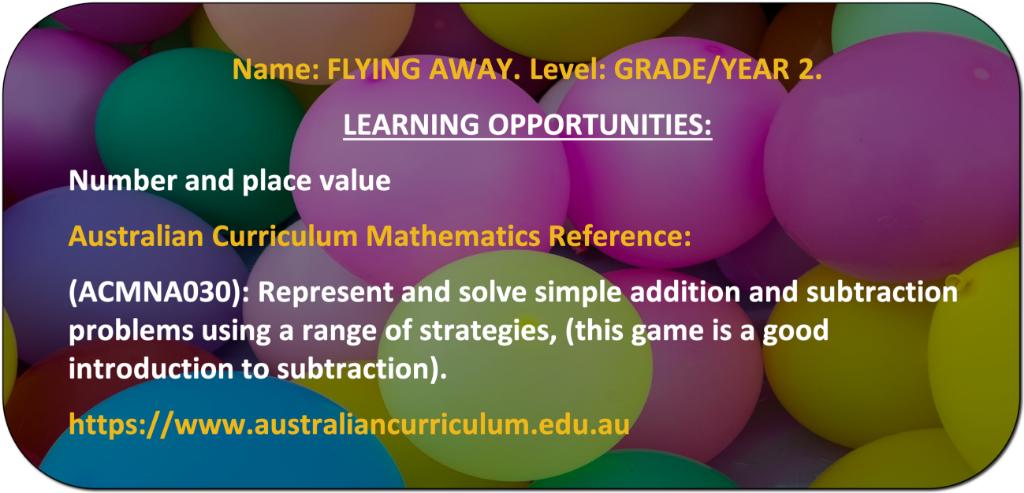
Flying Away - Worksheet
By the end of Grade 2, students recognise increasing and decreasing number sequences involving 2s, 3s and 5s. They represent multiplication and division by grouping into sets. They associate collections of coins with their value. Students identify the missing element in a number sequence. Students recognise the features of three-dimensional objects. They explain the effects of one-step transformations. Students make sense of collected information. Students count to and from 1000. They perform simple addition and subtraction calculations using a range of strategies. They divide collections and shapes into halves, quarters and eighths. Students order shapes and objects using informal units. They tell time to the quarter-hour. They draw two-dimensional shapes. Students collect, organise and represent data to make simple inferences.
https://www.australiancurriculum.edu.au







